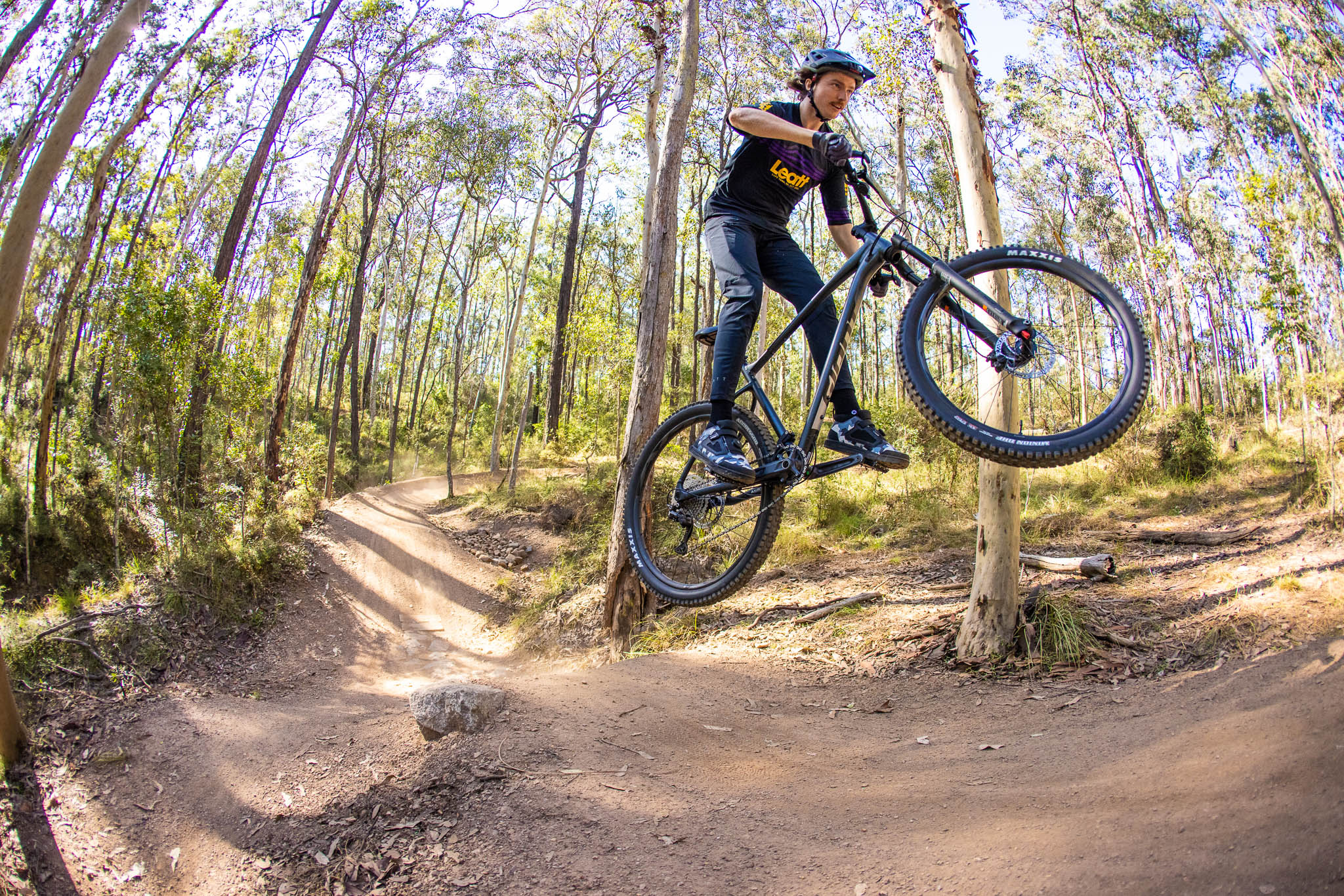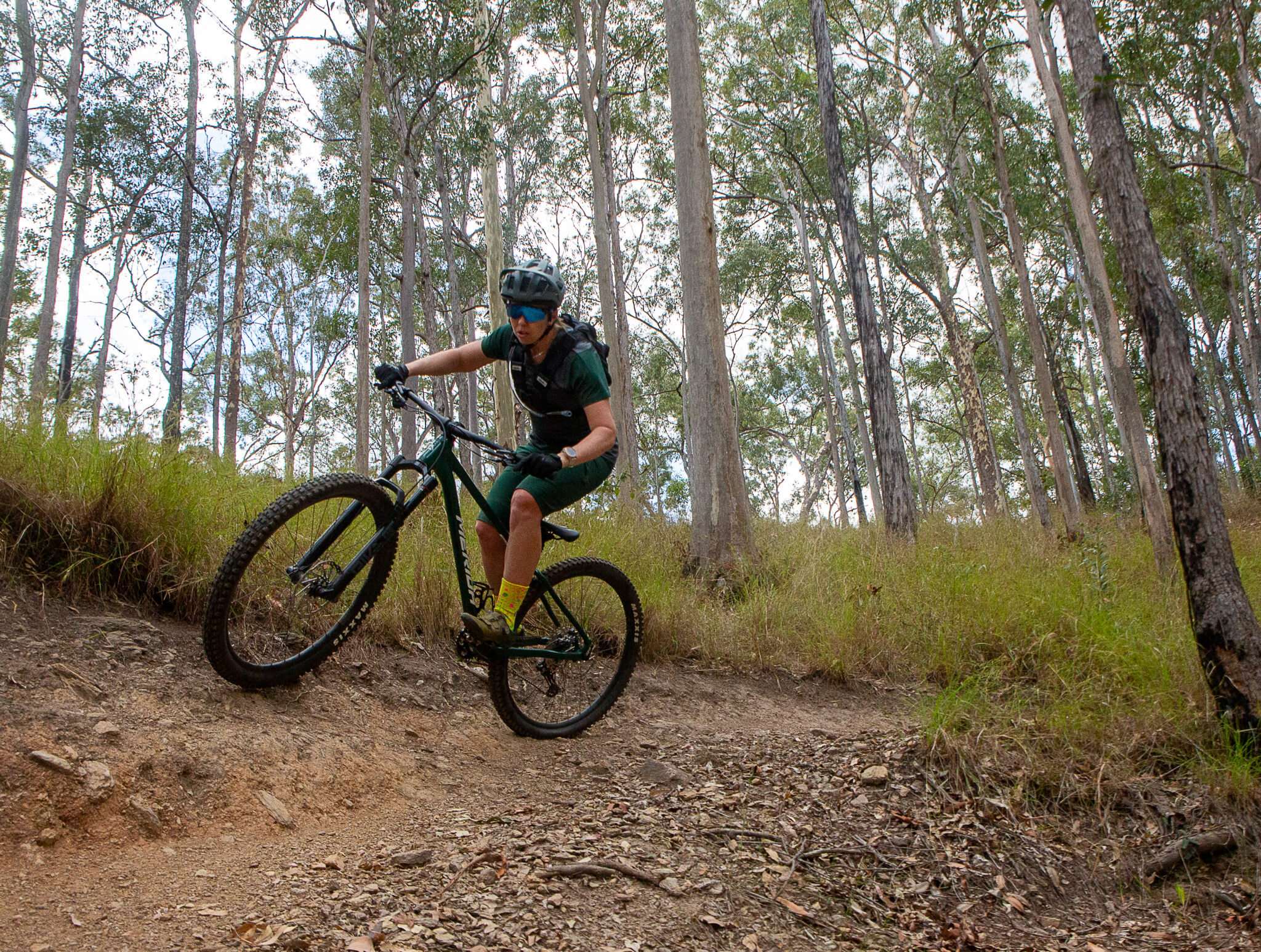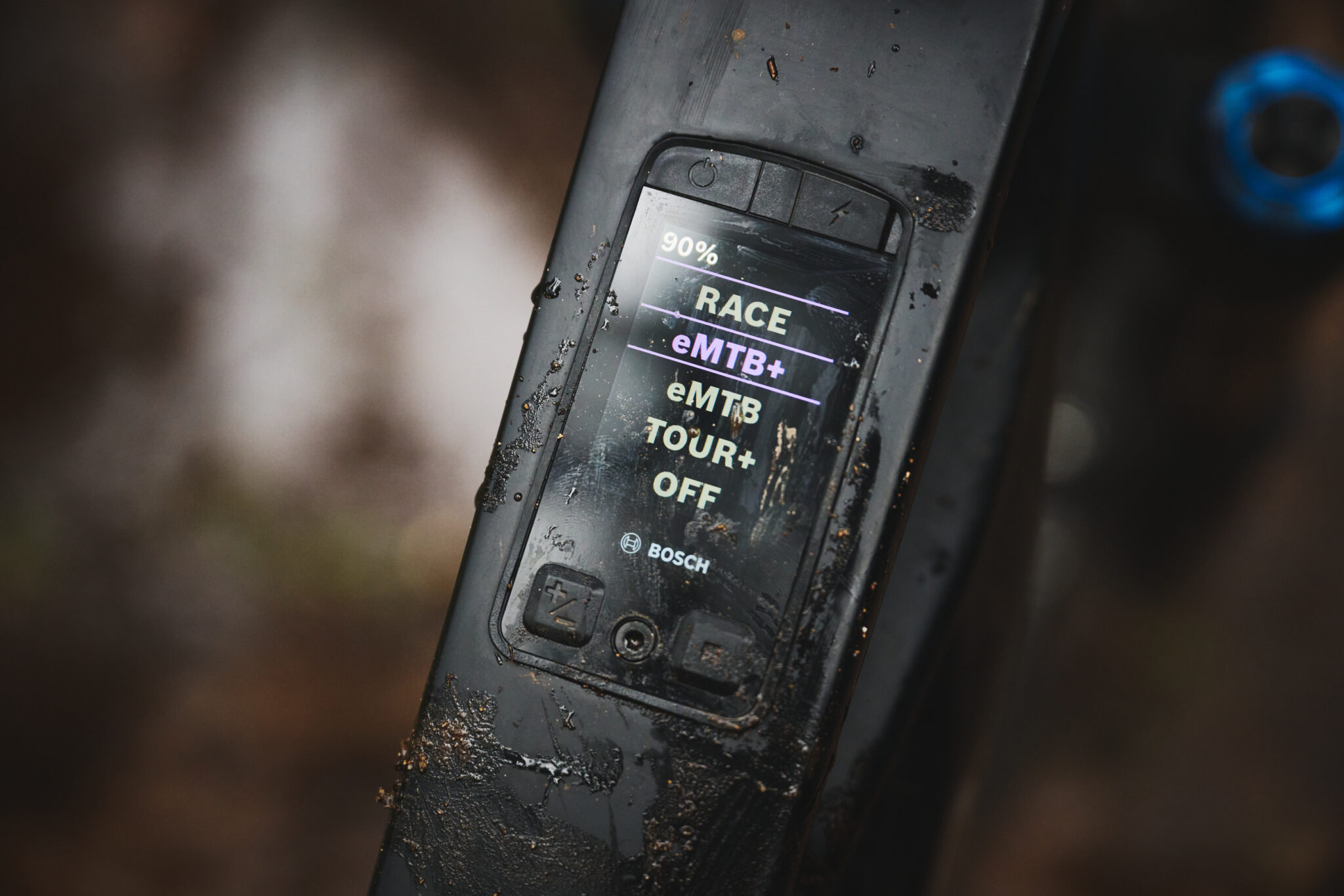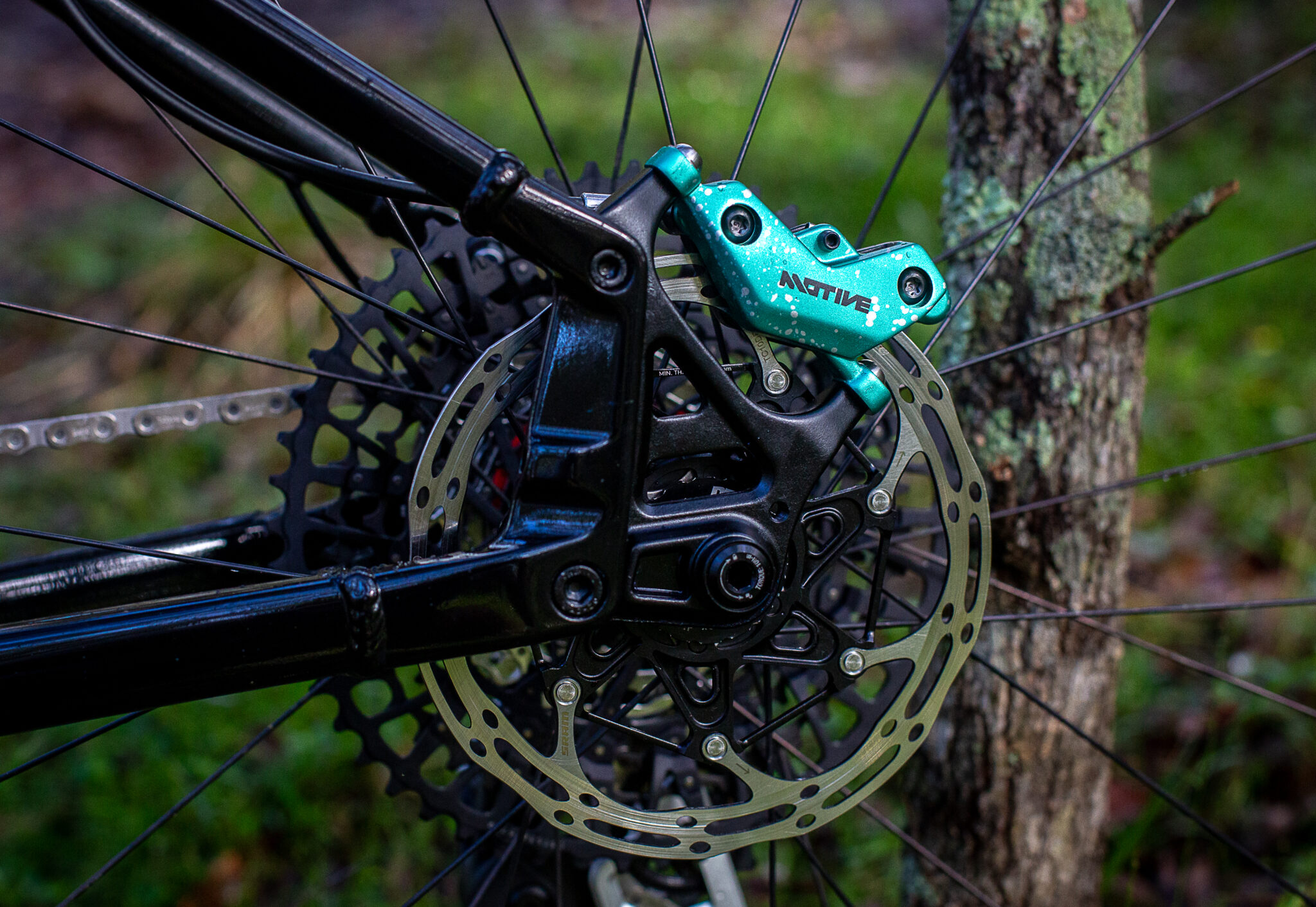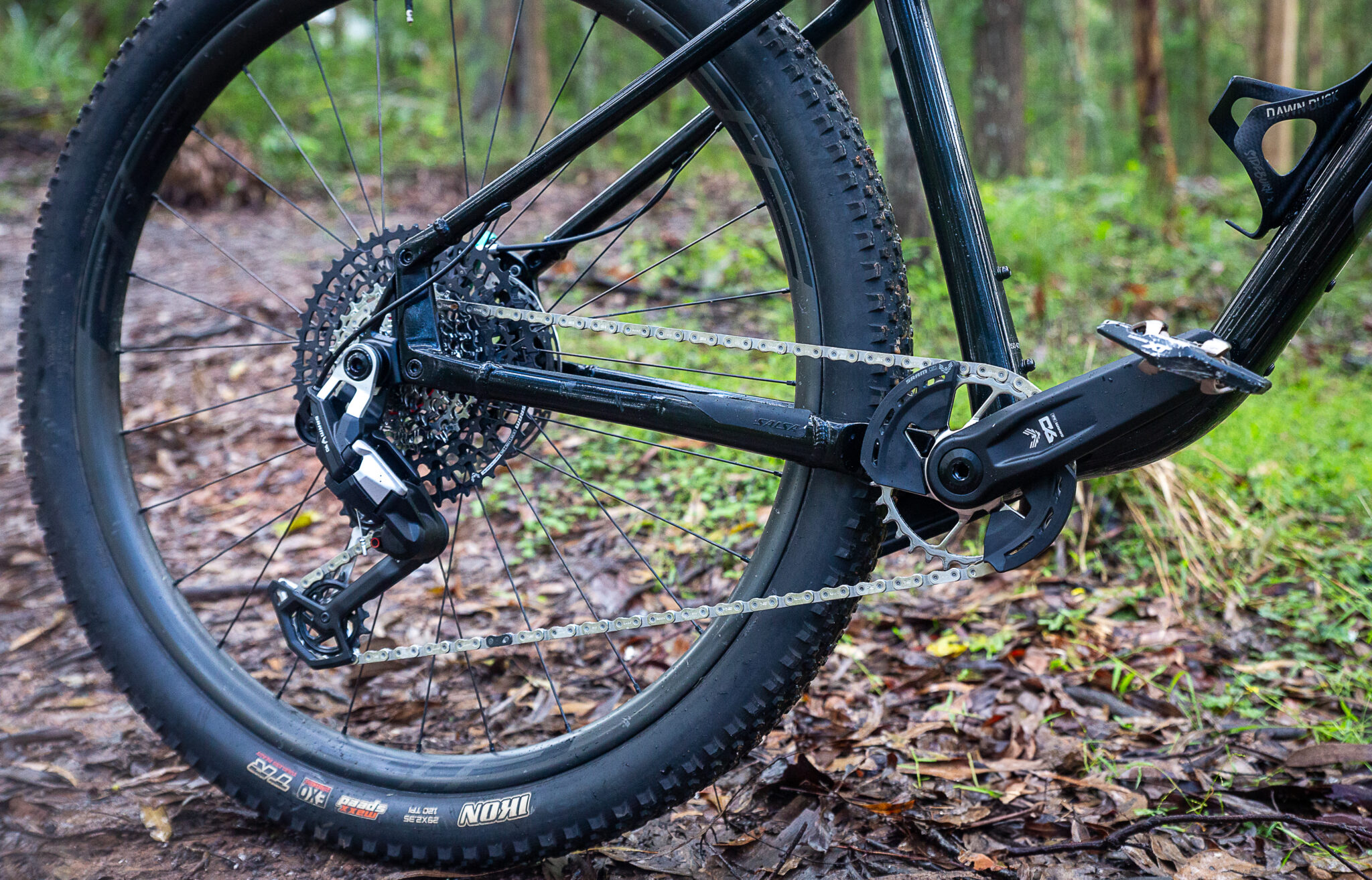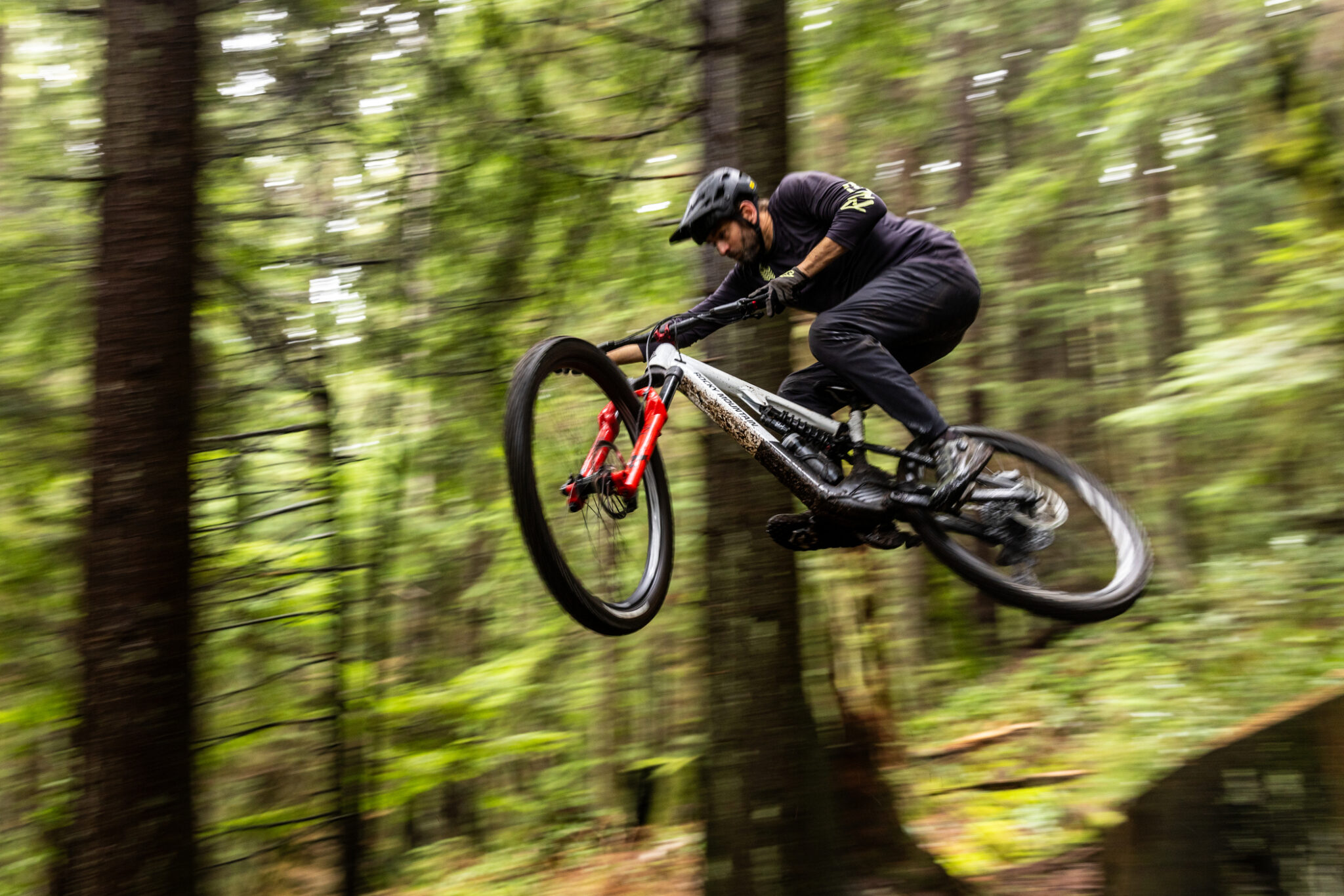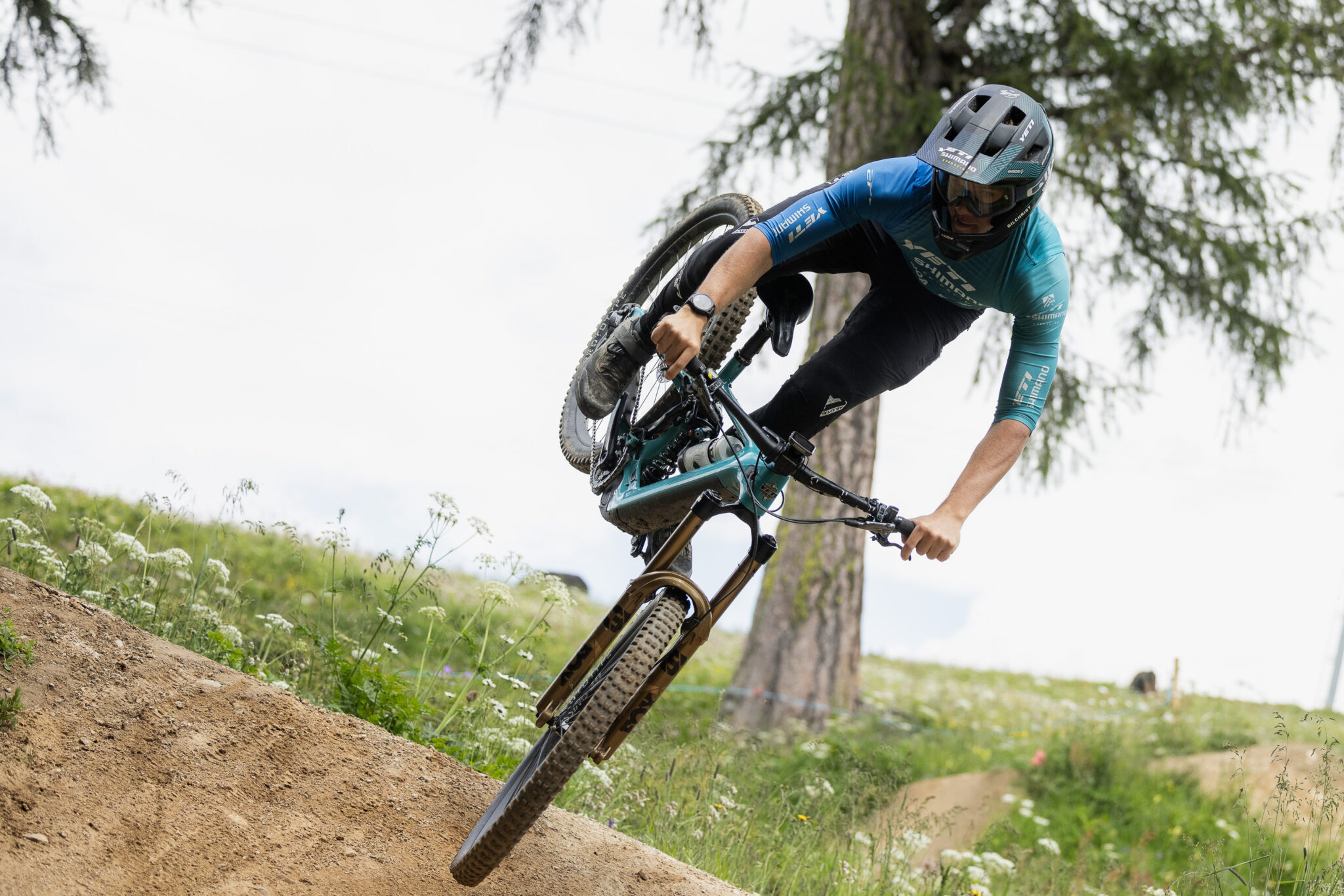Best Hardtail Mountain Bikes Under $2000
Budget hardtail mountain bikes... They're all hardtails, all 29ers, all under $2000. And we had fun on every single one of them.
Words: Mike Blewitt, Hayden Wright | Photos: Gerard Lagana
Here are our picks of the best hardtail mountain bikes under $2000
At AMB we get to test many lovely mountain bikes. Even in the past 12 months we have been lucky to ride and review a top shelf Trek Fuel EXe, a Factor Lando XC rocketship, a premium Fantic XEF 1.9 eMTB, and of course the new Specialized Levo SL. While a premium bike is a blast to ride, it’s not the only way to enjoy mountain biking. In Issue #201 Daisy Day pointed out that if the bike industry worked to have more well-made bikes available at lower price points, and cycling media promoted them, then the benefits to the sport, people and even the environment would be huge. Here we test 8 hardtail mountain bikes under $2000.
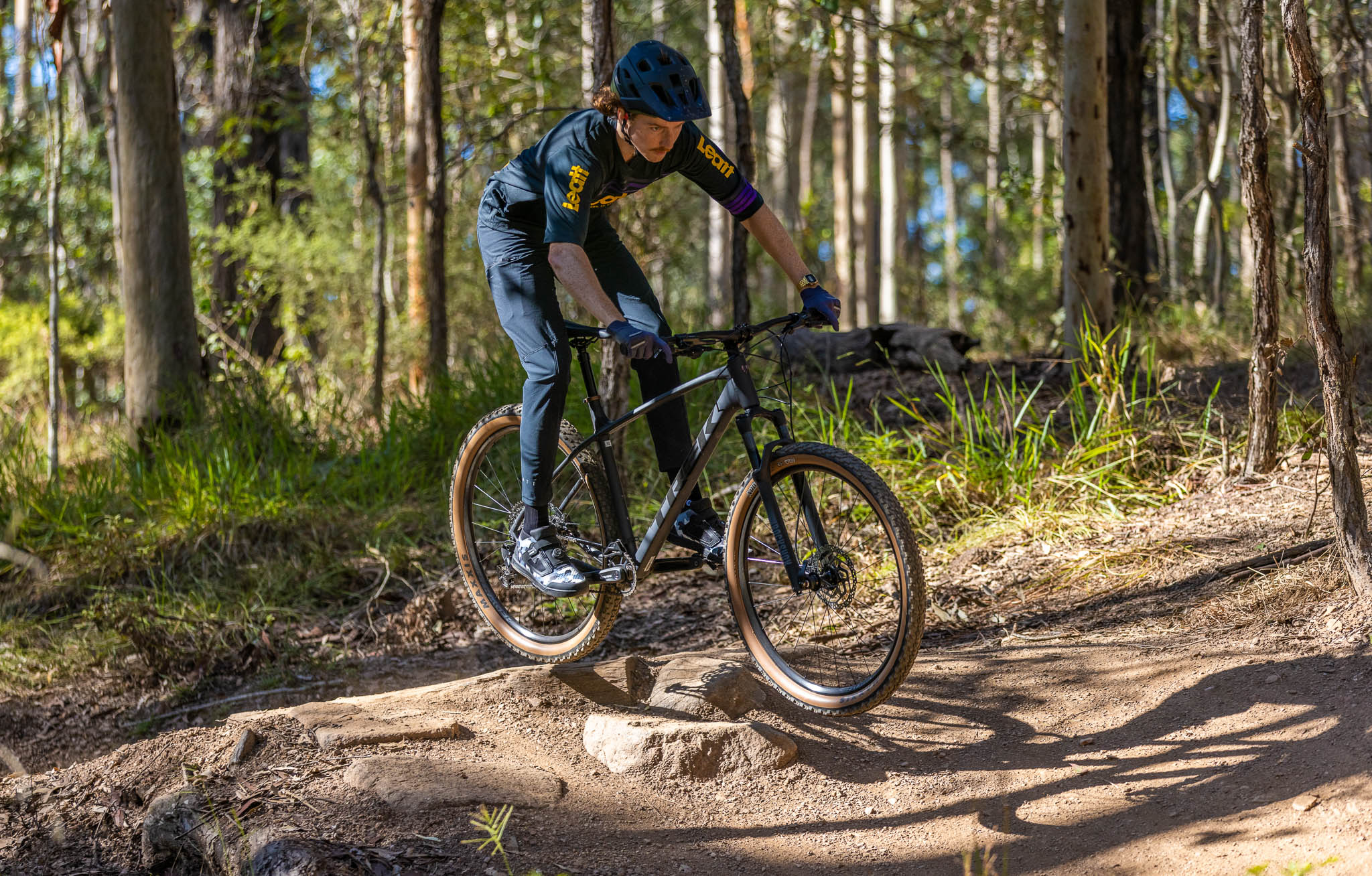
‘The social inclusion element of sustainability empowers those that have less access – it helps build resilient communities, which in turn makes institutions, industries, and companies accessible and accountable to people. It may sound like a stretch to include affordable mountain bikes in this category, but I truly believe that the more people (of any social standing) that can enjoy a sport that helps them enjoy the natural environment in a low impact way – can only be a good thing.’
Daisy went on to relate that plenty of brands do this already, with a bunch of innovative, good-value and well-made hardtail mountain bikes in the $1000-$3000 price range. And that people out on the trails, or submitting user reviews of them talk about the FUN they are having off road.
And this matches some of our own experiences here at AMB. The Polygon Siskiu D7 we tested in 2020 was a blast to ride. As was the Merida Big Trail 500 later that year. So we reached out to all the major (and some smaller) bike manufacturers, to see who would be interested in submitting budget hardtail mountain bikes under $2000 for this group test. The 8 bikes featured represent a price range of $999.95 to $1999.95. They’re all hardtails, all 29ers, and we had fun on every single one of them. Given the price range and the fact some of the bikes scream XC, while others are angled towards all-round trail use, here are the main things we are assessing each bike on.
Best Hardtail Mountain Bikes Under $2000
- Marin Team 1 – $1999
- Trek Marlin 8 – $1899.99
- Merida Big.Nine SLX – $1999.99
- Norco Fluid HT2 – $1699
- Cube Attention SL – $1799
- Reid Tract 4 – $999.99
- Giant Fathom 2 – $1899
- Cannondale Trail SL 4 – $1899
Features of budget hardtail mountain bikes
From the frame itself to the componentry, any rider should have a tick list when buying a new bike. Overall, these may not be must haves, but they are things that should stand out. The more, the better:
- Boost (148mm) through axle frame
- internal dropper post routing (or a dropper post as stock)
- Wide range 1x group set
- Adjustable suspension fork
- Wide bars
- Clearance for wide tyres
- Tubeless ready
- Serviceable parts
- Two piece cranks with external bottom bracket
Geometry and handling
What we are looking at here is geometry that takes some cues from performance handling bikes. So head angles that are likely slacker than 70 degrees, so steering isn’t nervous. Plus we’d like to see a steeper seat angle for better overall balance when climbing. We’ll see how it transfers to the trail, and explain where the bike excels and why. The size range available is also a big consideration – as you need to be on a bike that fits.
Ergonomics
This always comes down to personal fit, but we’re looking at things that make the bike more comfortable to use and ride – and therefore more fun. Small changes in handlebar width and shape make a difference, as do brake lever shape and size. Some models offer more adjustment than others, and some brake levers don’t work as well as they could with some gear shifters. When the ergonomics are good, you don’t think about shifting and braking – you just do it. That’s part of making bikes fun and comfortable.
Components
There isn’t too much mystique with bikes and components. The ones that cost more work better. So given the price range in this test, what we are looking at is about ease of use, servicing and how well they suit these budget mountain bikes. This is partly relating to ergonomics, but also how fit for purpose the given parts choice is. As an example, we’d rather see a heavier crank set with a replaceable chain ring, than something lighter and flashier that would require the whole crank set replaced when the chain ring wears or gets damaged. A good budget bike shouldn’t have parts that require more expensive upgrades to keep it running over time.
READ: AMB’s Top 4 Cross Country Tyres for 2024
Fun factor and suitability
This is the big one – was the bike fun to ride? And also, who does it suit? Some of these bikes are trail rippers, others could be awesome rail trail crusaders. We’re testing for suitability, and will summarise what kind of riding each bike suits, and why.
Testers of the budget hardtail mountain bikes
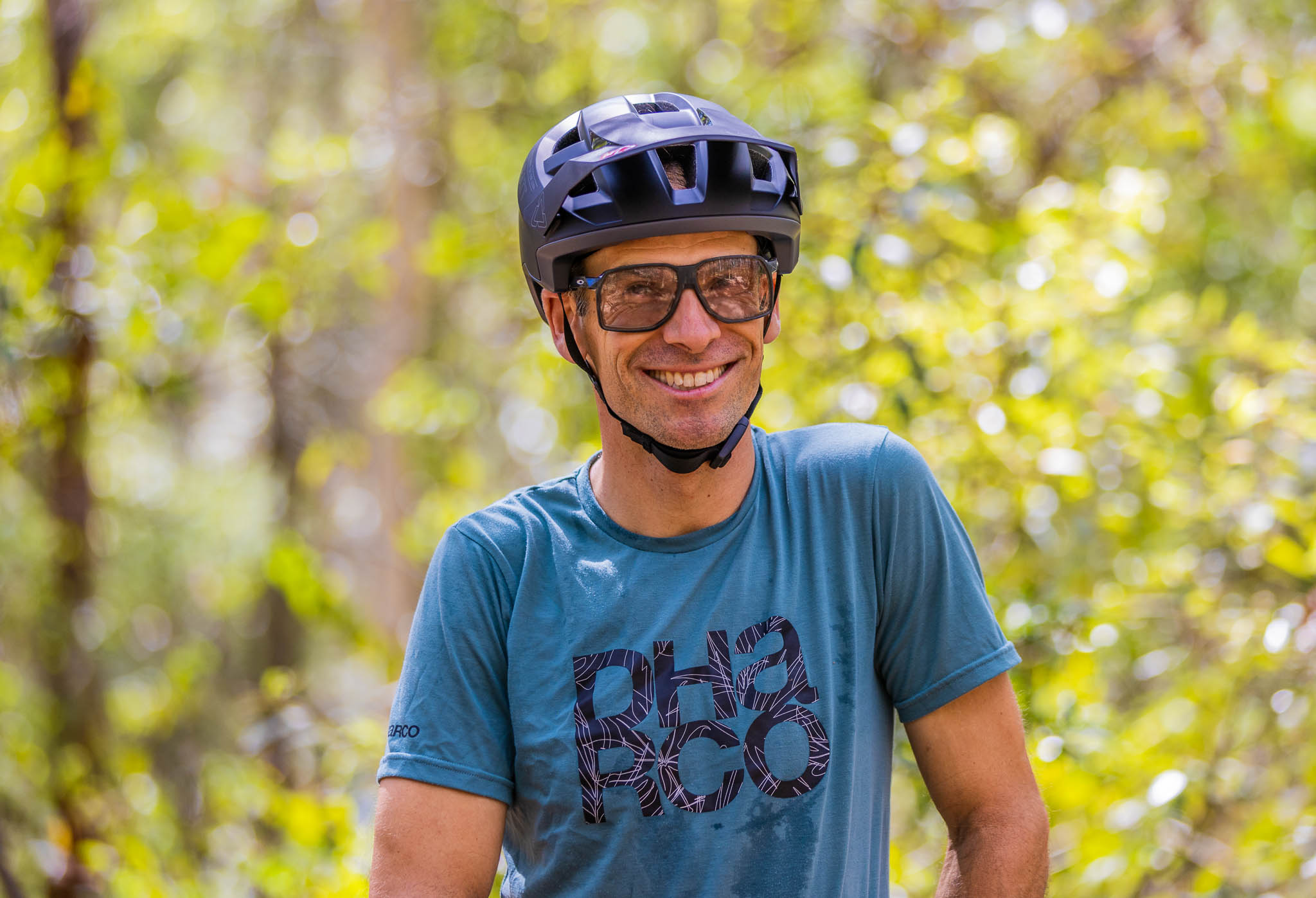
Name: Mike Blewitt
Height: 178cm
Weight: 73kg
Experience: Enough to run the show
Special move: Staunchly grounded
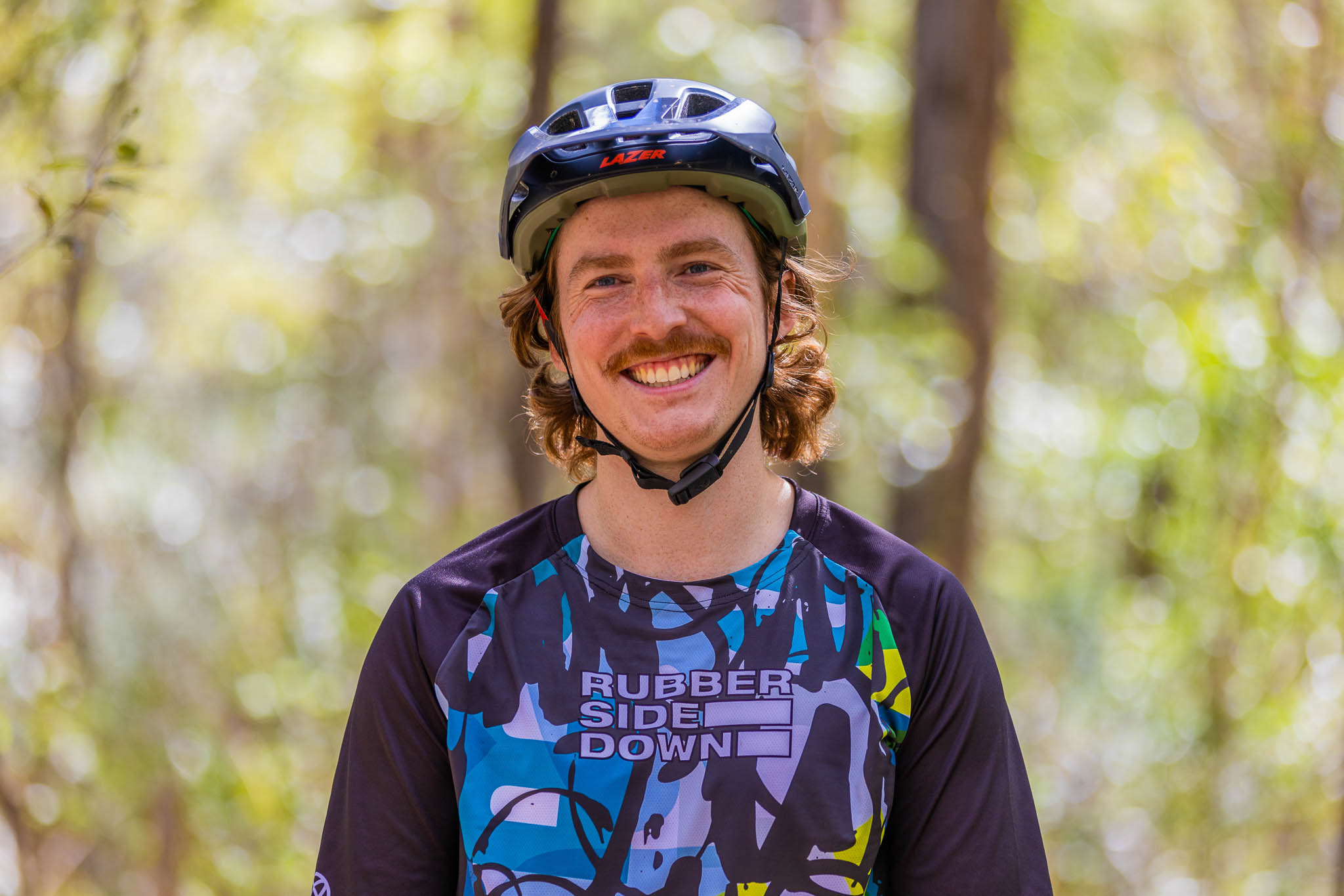
Name: Hayden Wright
Height: 193cm
Weight: 80kg
Experience: “I’m an engineer”
Special move: Tucking the front end
Women’s specific hardtail mountain bikes
As you’ll see, none of the budget mountain bikes tested are women’s specific, and there aren’t many on the market. But there are a few things that make a difference for any rider, as our Deputy Editor Georgina von Marburg explains.
“If you’re a woman, the right bike is not a ‘female specific’ bike. It’s a you specific bike The same principle applies to men. Each rider is totally unique in their body structure, whether that’s height, inseam, torso length, weight, and of course – riding style. Virtually any bike can be made to cater to you specifically. Whether this bike is $1200 or $12,000, the saddle, seatpost height, grips, and handlebar width are all things which are easily adjustable. You should consult a knowledgeable bike shop or bike fitter on these topics.”
“Your riding style will determine things like suspension setup, crank length, and how much drop you need in your dropper post. These adjustments are a little more time and money consuming, but will dial in the bike to suit your needs.”
Imogen Smith, a long term AMB contributor, echoes the same sentiment.
“Women come in all shapes and sizes. If you’re a lady, it’s more than likely that you don’t actually need women’s-specific geometry. The right bike for you is a combination of things: suitability for purpose, fit, price, colour… That could be any bike.”
“Here’s the adjustments I make to my unisex bikes. I make sure the geo is going to fit me (this could mean getting a proper fit if it’s a new bike). I cut the bars down. I put on a saddle I like (which by the way, isn’t a women’s-specific saddle). I have a crank length I know works for me and so I put my cranks on. Most people won’t need to do this, it’s more something ingrained after 20 years of pedalling the same sized circles.”
Marin Team 1 – $1999
Tester: Mike Blewitt
Marin Bikes have a home with Bikes Online in Australia, and they have helped countless riders around the nation find a great bike for the trails via their direct to consumer model. Marin bikes are bought online and shipped to your door, and as such their website is setup to help equip you on choosing the right size, the right model – and building it up. They even have free 14 day returns!
The Marin Team 1 is called an aggressive XC bike, but what does that mean? Well it’s fairly light for efficient bike riding, but with components and handling to suit aggressive riding as well.
Features of Marin Team 1
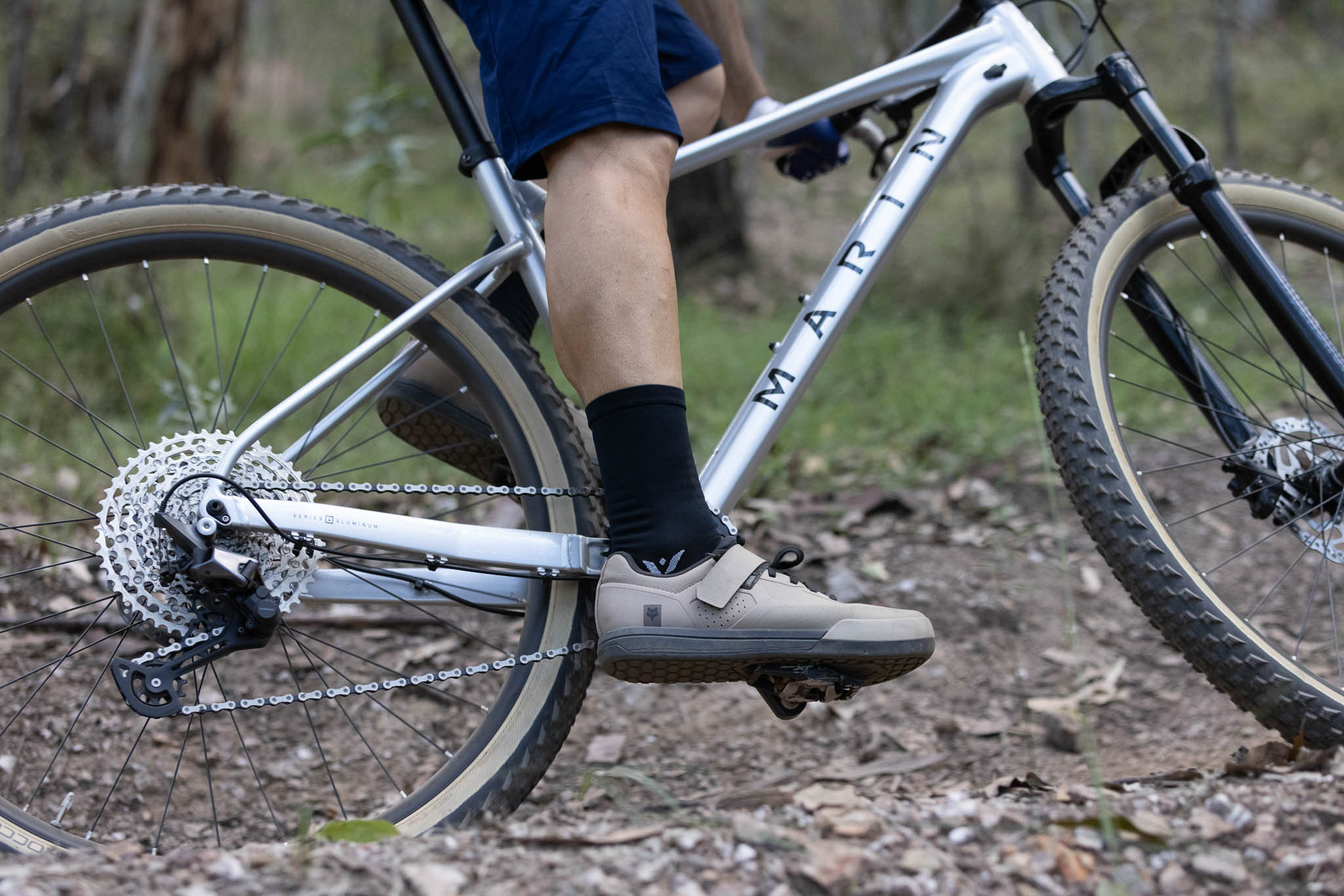
The Marin Team 1 shares the same frame as the Team 2. It has internal routing, including for a dropper post, wide tyre clearance, a great finish, and 148x12mm Boost rear axle spacing, and a 110mm Boost spacing front suspension fork. It’s great to see the RockShox Judy TK has an air spring with rebound adjustment and lock out – to aid in getting it set up to suit a wide range of riders. The group set is a wide range Shimano Deore 12-speed group for precise shifting.
Geometry and Handling
The layout on this bike walks a nice line between traditional cross-country handling and a more confident trail bike. The 68 degree head angle is very close to what a modern cross-country bike would be using, and paired with the wider handlebars, short stem and 450mm reach in large, the bike is agile but also steady at speed. The 74 degree seat angle keeps you central over the bike when climbing, to stop the front wheel wandering around, assisting when navigating steeper climbs and technical ascents.
The bars are quite wide at 780mm, and many riders may opt to trim them a little so suit their needs, which is easier than making them wider. Wide bars do offer more control in rougher trails, so kudos to Marin for speccing these, along with a short stem, to help riders tackle more aggressive trails with less fear of going over the bars.
Ergonomics
Everything falls nicely into place on this hardtail mountain bike, as the geometry is well designed. If I had to be picky, the Shimano MT200 levers are not a favourite, but common at this price range. They’re quite long, so need to be set a long way inboard on the handlebar to use them for one finger braking – which the brakes are strong enough for. These small adjustments will make a big difference for any rider’s comfort and fit. Of note, at 178cm my seat height was near the maximum for the 350mm post on the large frame size.
Components
Given the Marin Team 1 is at the top of the price range, it should be no surprise that the parts are a good mix. The Shimano Deore 12-speed group set is a great choice, with durable parts that shift well under load, while having a wide gear range. The RockShox fork is a big brand, and while it’s an entry level fork, it can be adjusted for rider weight, with rebound adjustment to aid control. RockShox forks are also easier to have serviced, with parts being readily available.
Special mention should go to Marin for the wheels and tyres. With 29mm internal rims that are tubeless ready, and 2.35” tyres, riders on this bike can work to get proper traction and comfort off road. The wider rim allows for more stability when cornering with a wider tyre, and a greater contact patch for more traction.
The only downside is the chain ring and cranks. They work fine – however the chain ring isn’t truly replaceable. So when the chain ring gets worn, or damaged, you may be up for a new set of 24mm cranks. There are nearly unlimited options with this fitment, but we’d prefer to see an easily replaceable chain ring, as opposed to a whole crank set being replaced.
Fun Factor on the trail
With great ergonomics and handling, plus a low overall weight within the line-up of test bikes, the Marin Team 1 was a dream to get on and pedal. It responded really well to input through corners, with no crazy fork dive or deflections, even on a 32mm legged fork. The bike accelerates easily, and is easy to maneuver on the trails. The Marin was pretty quiet to ride – although some sort of chain stay protector would be a good addition to look after the paint.
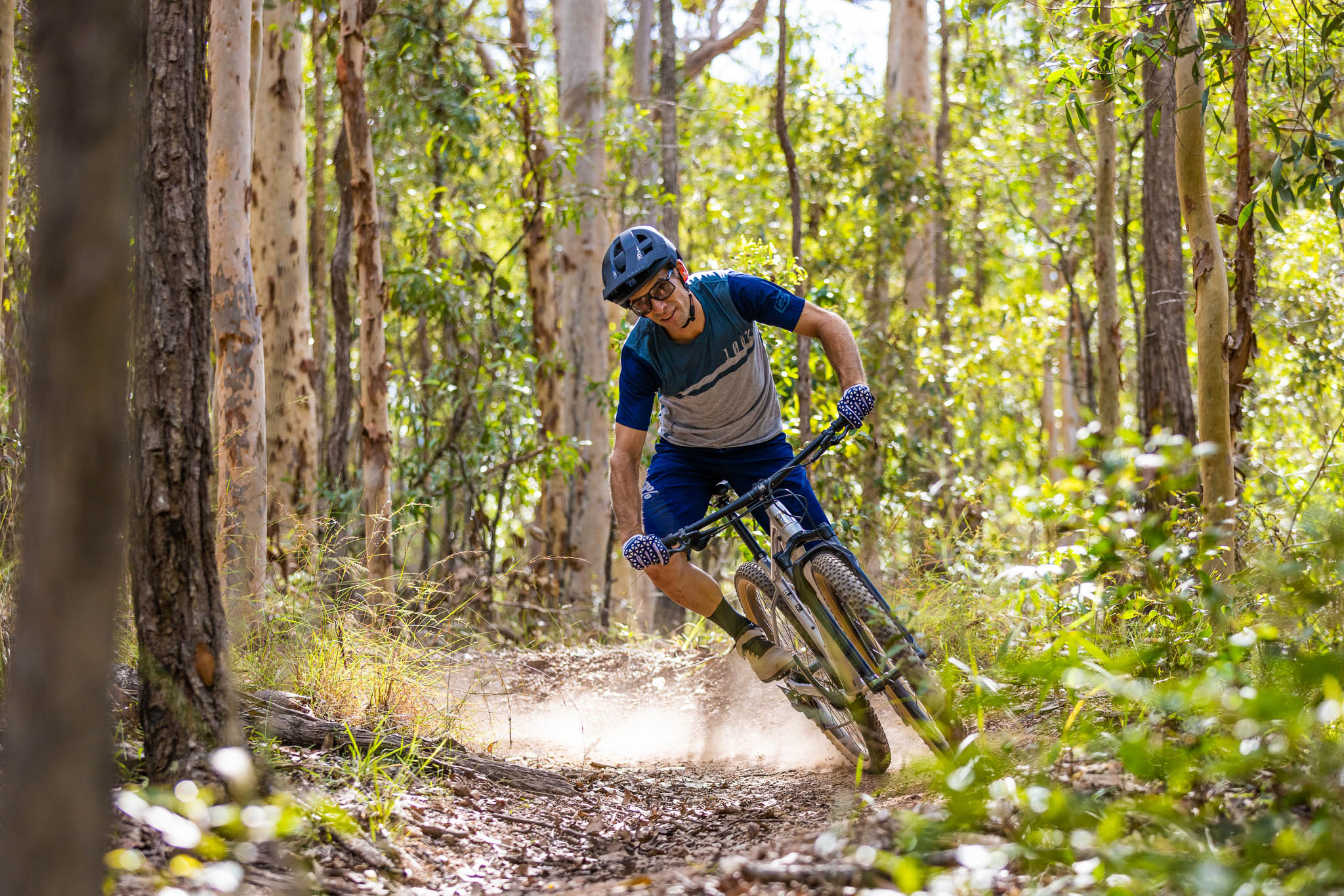
With very reliable shifting and braking, there was little to think about when riding the Marin. The shifting was consistent through the range, with no missed shifts. When the KMC chain wears out, upgrade to a Shimano 12-speed chain, as these are designed to work with their 12-speed cassettes for even better shifting under load.
With one of the better wheel and tyre combinations on test, it is worth getting the tyre pressures set right, and even converting the wheel set to tubeless to get more comfort and traction. This makes a big difference to how capable a bike is, and is really worthwhile. When descending, the stable tyre setup and larger footprint aids in confidence in the traction available – and for me it plays a roll for how well the Marin rides.
The low head tube helps the bike push through corners, and pairs well with the longer reach and wider bars, The front of the bike is really planted through snaking singletrack climbs, and it really excels on fast and buff trails. But when I was hitting rockier trails I was wishing there was a dropper post on the bike, as it does mean you are pretty low at the front. A dropper post is a relatively easy addition, and would bump up the fun factor for anyone looking at the Team 1.
Our take on the Marin Team 1
Bikes Online state that the Marin Team 1 is ‘XC light with trail riding capability’ and I would agree. It’s going to suit the rider who likes going fast on the trails both up and down. While I’d love to see a dropper post included, it’s actually better that Marin have included a wheel set with good hubs and wider tubeless compatible rims, plus a brand name RockShox fork and Shimano Deore 12-speed group set – as these items are pricier to upgrade later if that is your aim. It’s a great bike and excellent value, with capable handling for a wide range of trails, and frame and component features that will serve a rider over a number of years. If you want a bike to ride hard and fast on singletrack now, and make a few savvy upgrades over time – the Marin Team 1 is a great bike to check out. If you’re after something burlier, take a look at the Marin San Quentin 2, also $1999, which is a hardcore hardtail that is ready to party. Just bear in mind that you will need to build it yourself, or pay a bike shop to do it for you once it is delivered.
Best hardtail mountain bikes under $2000
Marin Team 1 – $1999
Trek Marlin 8 – $1899.99
Merida Big.Nine SLX – $1999.99
Norco Fluid HT2 – $1699
Cube Attention SL – $1799
Reid Tract 4 – $999.99
Giant Fathom 2 – $1899
Cannondale Trail SL 4 – $1899
All parts and specifications overview
SPECIFICATIONS
Marin Team 1
RRP: $1999
Weight: 13.42kg
From: bikesonline.com.au
Available Sizes: S, M, L (tested), XL
Frame Material: 6061 Aluminium
Fork: RockShox Judy Silver TK, 100mm
Shifter: Shimano Deore 12sp
Derailleur: Shimano Deore 12sp
Crank: Marin Forged alloy 2 piece, 32t, 175mm
Bottom bracket: BSA external sealed
Chain: KMC X12
Cassette: Shimano Deore 12sp 10-51t
Hubs: Shimano rear, alloy front, 32h, Boost
Spokes: 14g stainless, black
Rims: Marin alloy, 29mm internal, tubeless compatible
Tyres: Vee Tire Rocco, 29×2.3”
Brakes: Shimano MT201, 180/180mm rotors
Stem: Marin 3D forged
Handlebars: Marin mini riser, 780mm wide
Seatpost: Marin alloy, 30.9mm
Saddle: Marin Speed Concept
Trek Marlin 8 – $1899.99
In 1976 the first Trek touring bike rolled out of their humble headquarters in Wisconsin USA and out into the world. Since that day, they’ve strived to ensure every bike encompasses the sense of travel and adventure that their namesake is founded upon, with the Marlin 8 being no exception. Touted as a trail hardtail mountain bike, this bike is said to be at home whether you’re enjoying a morning at the trails, riding to school, or out on an all-day adventure ride. Admittedly, that is a fairly broad brush stroke for this bike to paint – but Trek have done well to pack a long list of features into this black and tan hardtail.
Features
This Marlin 8 has an eclectic mix of features which make it truly unique in our group of test budget mountain bikes. Starting at the rear, it has pannier rack mounts and provision for a kickstand. Moving to the middle of the bike we can see an internally routed dropper post, 12 speed SRAM drivetrain and square taper crank. Bump absorption is handled by a 100mm RockShox Judy, which has a straight steerer and quick release axle. To top it all off we have a relatively short stem, wide bar and the ever reliable Shimano MT200 brakes.
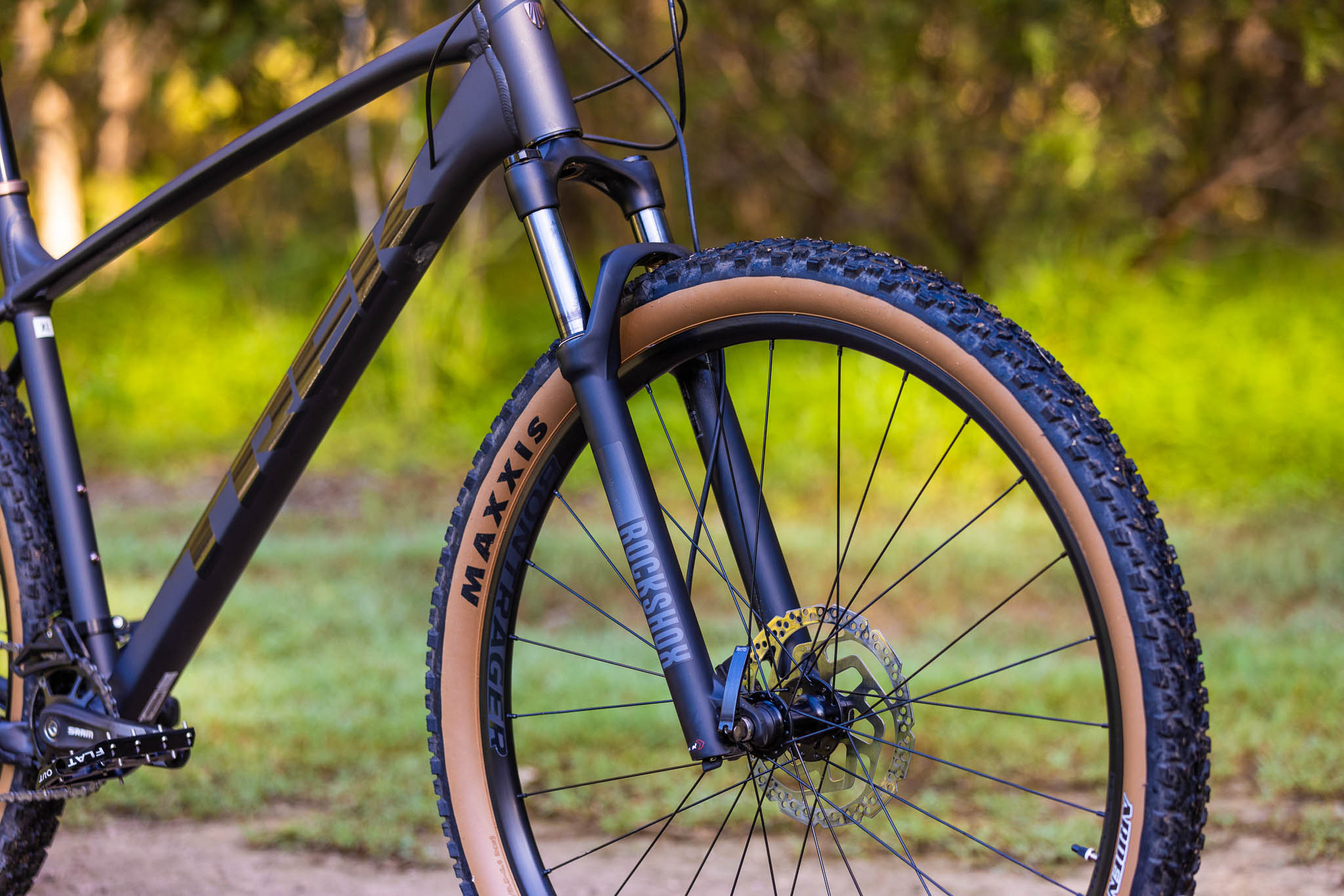
Geometry and Handling
Handling on this bike felt quite different to that of the Giant and Norco, irrespective of their near-identical geometry numbers. The Marlin has a 66.5 degree head angle, 73.4 degree seat angle and 495mm reach in the XL I tested. While the aforementioned bikes were better placed to go fast in a straight line, pop off lips and rail turns, the Trek felt more at home weaving through technical singletrack and scooting up climbs. It has a much more compliant character, thanks in part to its skinnier axles, surprisingly smooth 32mm fork, and narrow 28 hole rims. While this compliance was welcome at lower speeds, I did feel that it came at a slight cost when trying to push it on a descent. Alas, it seems we can’t have our cake and eat it too with the Marlin 8. I felt the RockShox Judy fork did a fantastic job of smoothing out trail chatter in all but the most extreme of events, further encouraging you to gravitate towards trails which were tight and technical. Having an air spring is always welcome at this price point, as it gives the rider ample opportunity to dial in the spring rate to their weight and/or speed.
Ergonomics
Nothing on the Trek grabbed my attention as being overly positive or negative. I found the contact points on this bike to be comfortable and really fit my body shape. The handlebar in particular has a nice sweep and profile, and was easily my favourite on the test.
Components
Trek have done a commendable job of modifying their component choice to best suit the target user across the 8(!) sizing options. Wheel size, fork travel, stem length, bar width, bar rise, crank length, and dropper travel all change depending on the size of the bike. This means you’ll end up with not just a frame size that suits your height, but a whole bike build that should be a good fit out of the box. Kudos to Trek for going to this length to make riders comfortable and confident on the Marlin 8. SRAM’s SX Eagle drivetrain is one I have used in the past with little negative experience. The range is wide and I did not experience any dropped chains or missed shifts. The fork has plenty of adjustment in both air spring and damping, and allowed me to get the performance right in the ballpark for this bike’s intended use.
Two negatives did stand out to me on this bike, but they both revolve primarily around serviceability and ease of upgrade. The Marlin 8 has QR cup and cone hubs, and a 3 piece crankset. In testing, they proved to be no issue however any upgrade down the road is going to require careful parts selection or additional spending to update the related parts to suit.
Fun Factor on the Trail
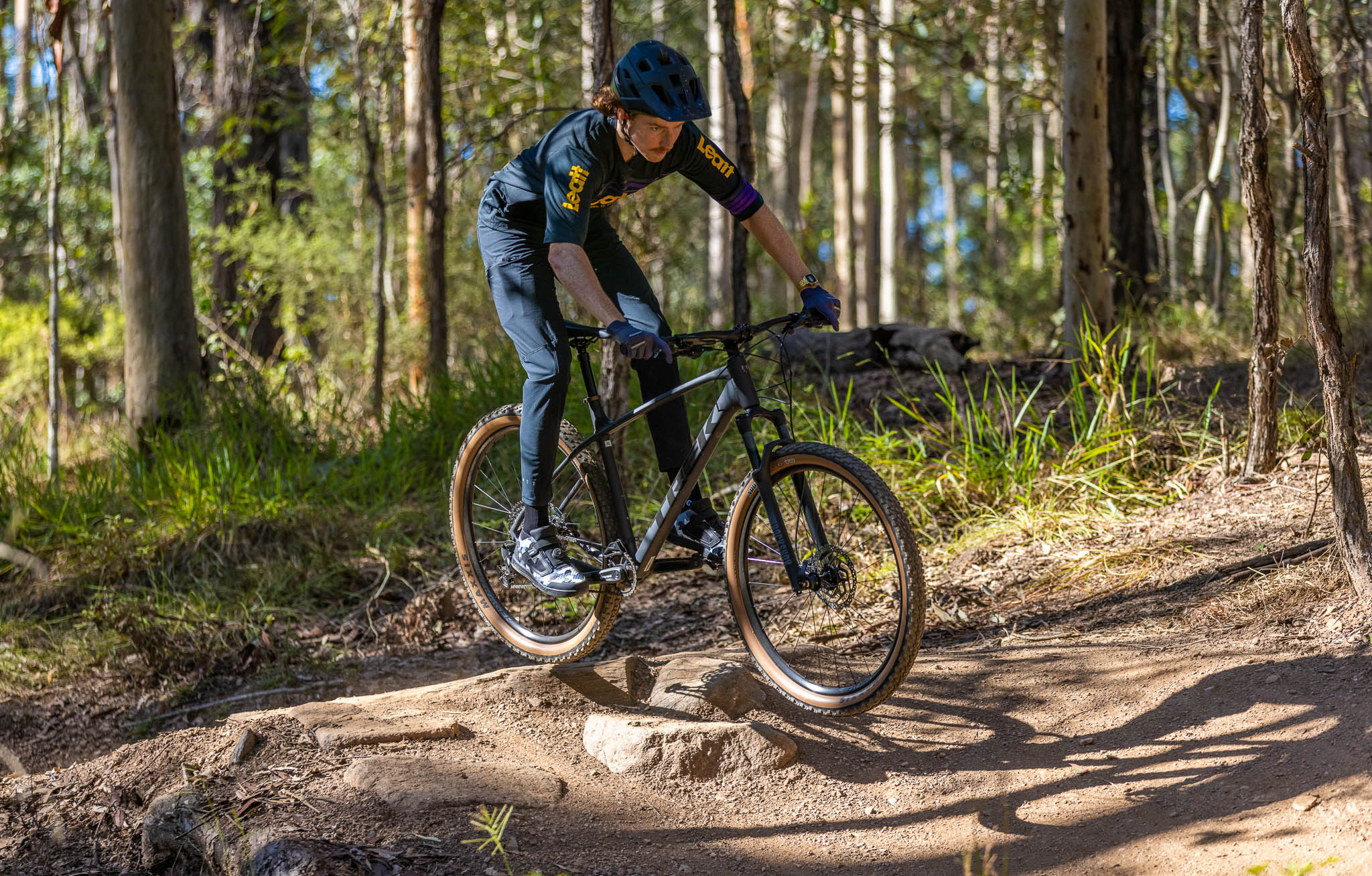
I had a great time on this bike exploring some of the lesser ridden XC trails in my local area. While Trek may market this bike as a Trail hardtail, I would put it down as a XC bike with geometry similar to what we are seeing on the World Cups at present. Fast, engaging, and quick to respond to rider’s input the Marlin 8 is very comfortable for hours on end thanks to its compliant chassis and smooth fork. The chassis did feel easily overwhelmed if I ended up going down something faster and rougher, but thanks to the dropper post and 180mm front rotor I was still able to keep things in check. Unlike the Norco and Giant, I would not be taking this bike out on any jump trails or black diamond runs – I don’t think the wheels are up to the task. Zipping around on singletrack is where this bike feels most at home. Alternatively, this bike did have me considering some adventures out past the horizon of my local trails. Thoughts of frame bags, tents, fire roads and weekend long rides were entertained with the knowledge that this bike would get me there and back in one piece.
Our Take on the Trek Marlin 8
Trek have delivered a versatile, feature packed bike with the Marlin 8. It has provisions for a wide variety of riders, be it bike-packers or XC racers. The head angle, dropper post and 2.4” tyres will save you should things end up on the wild side, but to me this bike is best suited to someone who wants to tick as many boxes as possible from their budget hardtail and who isn’t interested in upgrading it for the sake of performance or vanity. N+1 no more, if you want to ride to work Monday to Friday, hit some singletrack on Saturday and ride a rail trail on Sunday look no further – Trek have your bike with the Marlin 8. If you do want something a little burlier, then consider the Trek Roscoe 7. It’s a trail hardtail with a 140mm travel fork, Boost spacing, strong wheels and geometry that is ready to rumble. It sells for $2599.99.
Best hardtail mountain bikes under $2000
Marin Team 1 – $1999
Trek Marlin 8 – $1899.99
Merida Big.Nine SLX – $1999.99
Norco Fluid HT2 – $1699
Cube Attention SL – $1799
Reid Tract 4 – $999.99
Giant Fathom 2 – $1899
Cannondale Trail SL 4 – $1899
All parts and specifications overview
SPECIFICATIONS
Trek Marlin 8
RRP $1899.99
Weight 14.5kg (XL)
From trekbikes.com
Available Sizes XXS, XS, S, M, ML, L, XL (Tested), XXL
Wheel Size 26” (XXS), 27.5” (XS, S), 29” (M-XXL)
Frame Material Aluminium
Fork Rockshox Judy Silver, 100mm Travel
Shifter SRAM SX Eagle 12sp
Derailleur SRAM SX Eagle 12sp
Crank SRAM SX Eagle, 30T, 175mm
Bottom bracket Truvativ Powerspline
Chain SRAM SX Eagle, 12sp
Cassette SRAM PG-1210 Eagle, 12sp, 11-50T
Hubs Formula 6 Bolt, 28h, QR
Spokes Black
Rims Bontrager Kovee
Tyres Maxxis Ardent 2.4” EXO TR
Brakes Shimano MT200 Hydraulic, 180/160mm rotors
Stem Alloy, 60mm (XL) 31.8 clamp
Handlebars Bontrager alloy, 750mm wide, 15mm rise
Seatpost TransX, 150mm drop
Saddle Bontrager Arvada
Merida Big Nine SLX Edition – $1999.99
Merida are one of the biggest bike manufacturers in the world, and that always shows in the finish on their bikes, and the level of components they can put on a bike at a given price point. For value, they are often very hard to beat. Merida have a lot of budget mountain bikes under $2000, in both the Big Nine range and the Big Trail. We tested the Big Trail 500 in 2020, and if you’re after a high value trail hardtail, look them up. The Big Trail 500 has a 140mm travel RockShox Recon fork, Shimano 11-speed wide range group set, dropper post, a great wheel set and excellent trail geometry for $1999. We’d love to have one in this test as well – alas they’re so popular that Merida Australia are waiting for a restock. The Big Nine is a more classic cross-country hardtail, with a 100mm travel fork and agile handling, suiting riders tackling cross-country trails, bikepacking adventures and fast paced rides.
Features of the Merida Big Nine SLX
The Merida Big Nine SLX Edition has an alloy frame with a 135mm quick release rear axle. There is neat internal routing, plus mounts for mudguards and racks if needed. The frame has good tyre clearance for a 2.25” maximum tyre, and the Manitou Markhor fork has an air spring, plus rebound damping adjustment and a remote lock out. The Shimano SLX drivetrain is a stand out for shifting performance, and the brakes have excellent feel and stopping power.
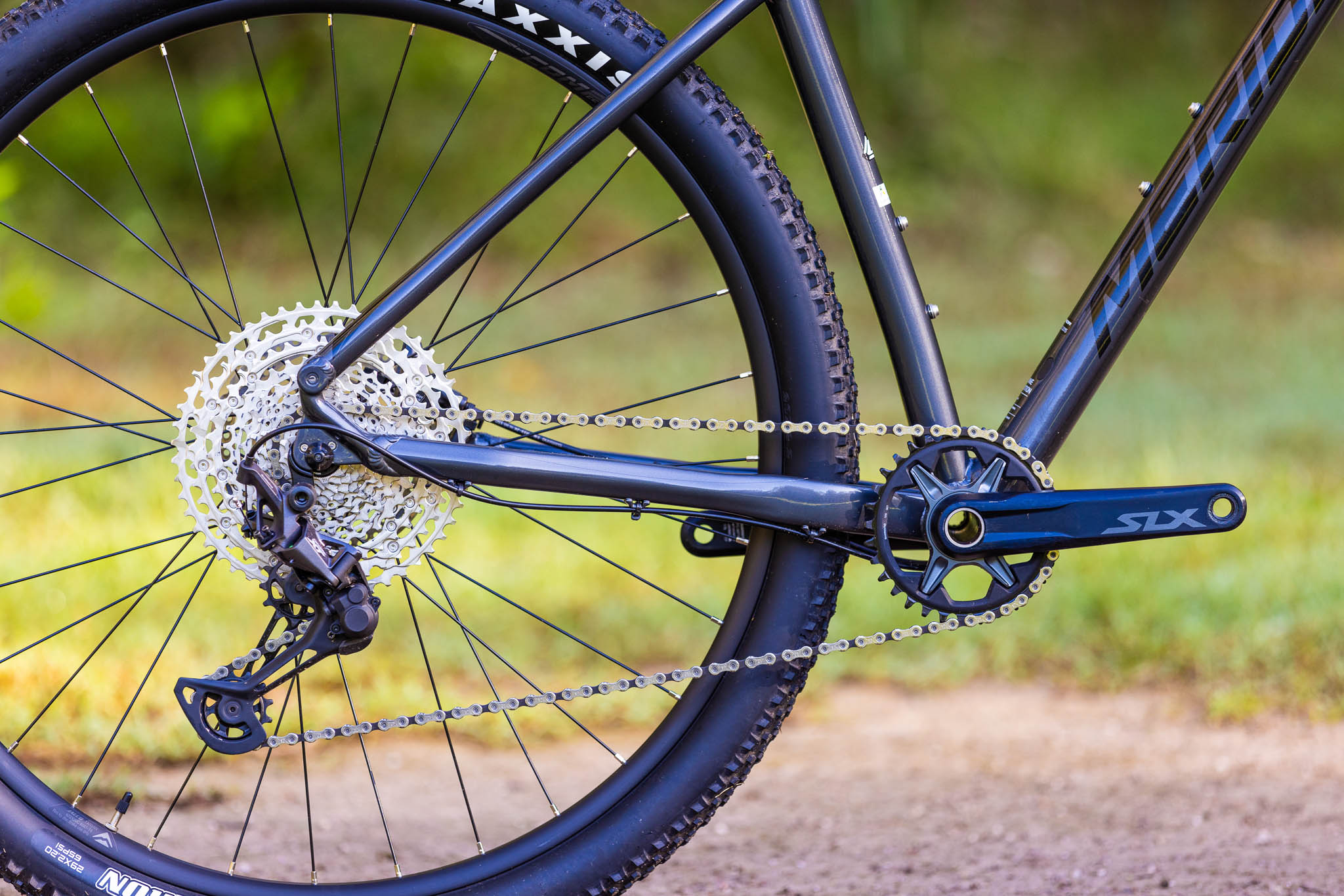
Geometry and Handling
Merida’s Big Nine frame has a classic 70 degree head angle and 73 degree seat angle, paired with a short reach. This means you have a fairly agile bike that handles on a dime, but is less stable on fast and rough descents. You’ll find the bike is easy to move around on flatter trails, but more of a handful in steep, technical terrain. This isn’t a fault, but it’s the intended purpose of the Big Nine. As such, it has flat bars and a longer stem to suit the shorter reach of the frame.
Ergonomics
While the geometry is the steepest and shortest on test, the bike is designed like that, with a slightly longer stem to make sure it handles as it should, and fits true to size. Importantly, Merida offer a wide size range from Small through to XXL. The Shimano brake levers use the new iSpec mount for greater stiffness, but still with the longer lever blade. I found the 760mm wide bars spot on, and the saddle and lock on grips were comfortable.
Components
The Merida Big Nine SLX Edition is at the top of the price range, and as such it has the best group set on test, with a Shimano SLX 12-speed drivetrain, including crank set, plus an upgraded Deore XT rear derailleur. The cassette is Deore, so a little heavier, and the brakes are M4100 two piston. Merida have fitted a 100mm travel Manitou Markhor Comp fork, which has an air spring, remote lock out and rebound adjust. It’s a Boost, through axle fork, but I did find it was mostly underdamped, even when running a lot more pressure than recommended, so while it added comfort it didn’t always aid control.
Merida’s own rims are quite narrow, but a good quality build. The Maxxis Ikon tyre is a well-rounded cross-country tyre, but the 2.2” model fitted has a very thin sidewall, and the tyres need a lot of pressure for much support when on the trails and in rocky corners. On the whole, this is a thorough parts package, and one certainly in keeping with what the Merida Big Nine is targeted for.
Fun Factor on the trail
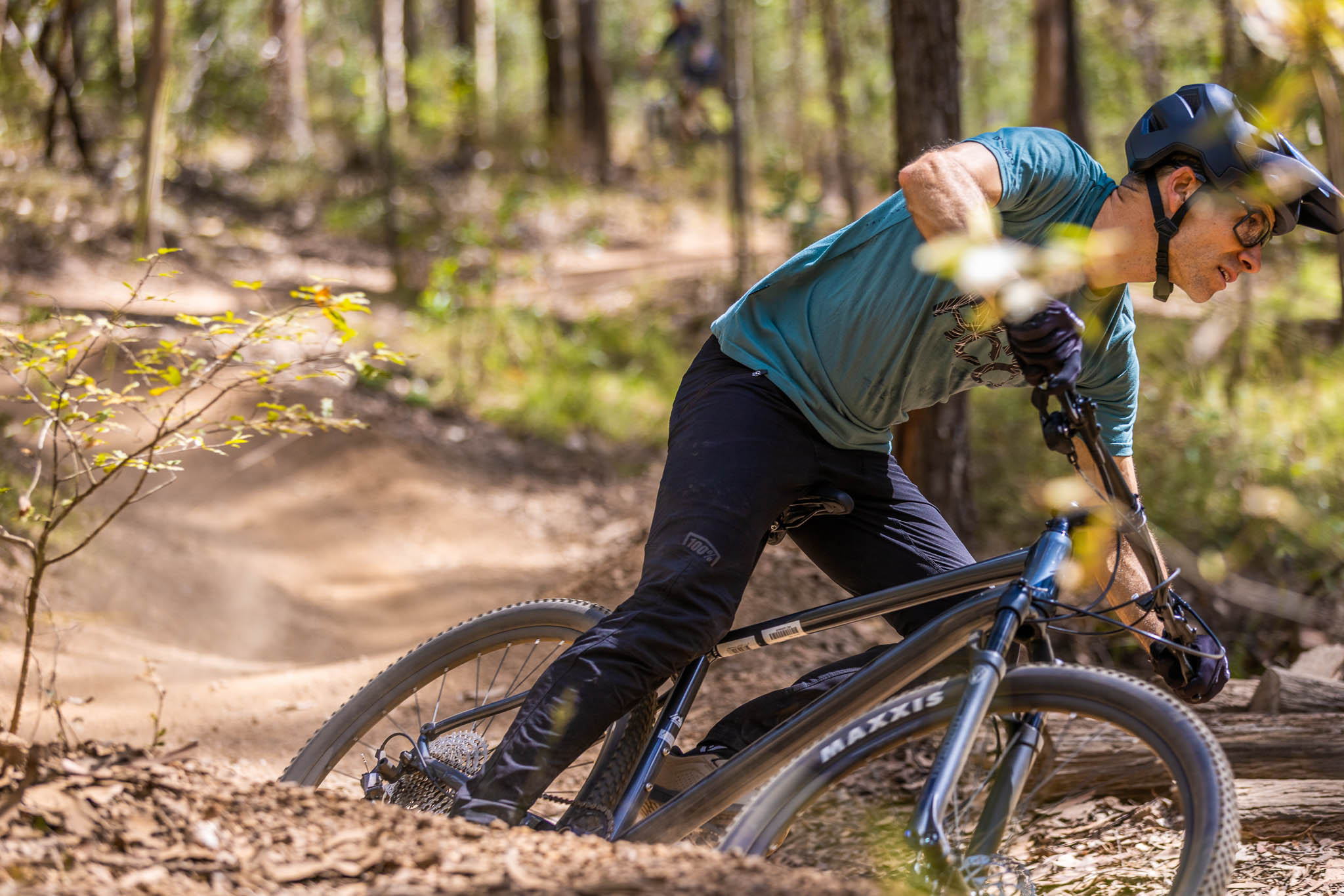
It wasn’t that long ago that I was riding and racing a hardtail with the same geometry as the Merida Big Nine. So while it’s a little steeper and shorter – it works! The Merida Big Nine climbed like a dream, and made short work of rolling firetrails and nicely prepared singletrack – which is common in most rider’s local singletrack networks.
Zipping from corner to corner, and stabbing the pedals to get a bit more speed for small step ups was all taken well within the Big Nine’s stride. Out of the saddle and hauling on the bars, the Big Nine responds as you’d expect, and shifts under load admirably.
On faster descents, a steady hand on the tiller is rewarded by a bike that reacts fast to your input. Where I found the Big Nine faltered was in rockier corners, and in terrain where the bike would have repeated hits. Be it rocky step downs, extended rock gardens, and even G outs and V ditches. In these moments, both the fork and the wheel set would be overwhelmed. I found it hard to set the fork up so it didn’t blow through the first half of its travel, and the rebound damping didn’t have much impact given the higher spring rates needed. And the light tyres and narrow rims meant you either had to run high pressures and deal with the lack of traction, or have a wheel and tyre system that had too much movement when pushing into corners and features.
But to be fair – this isn’t strictly what the Big Nine was designed for. The Big Nine is best on those fast, swoopy trails. It’s great for the big exploration rides on firetrails and paths, and blasting around the trails that aren’t littered with rock gardens.
What made it fantastic to ride was how well the brakes and gears worked through the entire test period. I think that seamless shifting and reliable braking go a long way towards a rewarding riding experience, and the Merida Big Nine really nails that.
Our take on the Merida Big Nine SLX Edition
The Merida Big Nine SLX Edition stands out for a few reasons in this group test. It has the best overall group set, and this will result in a bike that has smoother shifts, even under load, for longer. Parts that have a longer service life mean you will be able to enjoy riding the bike for longer between services, and they will likely have a longer life as well. The Merida Big Nine SLX Edition is going to suit a few types of people. One would be the person wanting to get off road and explore. Forget a dropped-bar gravel bike, a 29er hardtail is the perfect gravel bike! You’ll have the traction and comfort to go explore some wild back roads, forest roads, and wooly firetrails on this bike. It’ll also suit the riders looking for a bike for mixed use. Meeting friends for a quick ride on the trails at 6, but need to be at the office by 8? No stress, the Big Nine is a fantastic bike to punch out the commute, as much as it suits some fast laps on the local trails. If you know you want more, pure off-road performance, look to the Big Trail range, or the Big Trail 500 at the same price of $1999.
Best hardtail mountain bikes under $2000
Marin Team 1 – $1999
Trek Marlin 8 – $1899.99
Merida Big.Nine SLX – $1999.99
Norco Fluid HT2 – $1699
Cube Attention SL – $1799
Reid Tract 4 – $999.99
Giant Fathom 2 – $1899
Cannondale Trail SL 4 – $1899
All parts and specifications overview
SPECIFICATIONS
Merida Big Nine SLX Edition
RRP $1999
Weight 12.34kg
From merida-bikes.com
Available Sizes S, M, L (tested), XL, XXL
Frame Material Aluminium
Fork Manitou Markhor Comp, 100mm
Shifter Shimano SLX 12sp
Derailleur Shimano Deore XT 12sp
Crank Shimano SLX, 32t, 175mm
Bottom bracket Shimano BB52 external
Chain KMC X12
Cassette Shimano Deore 12sp 10-51t
Hubs Shimano MT400
Spokes 14g stainless, black
Rims Merida Comp CC, 20mm internal
Tyres Maxxis Ikon 29×2.2”
Brakes Shimano M4100, 180/160mm rotors
Stem Marin 3D forged
Handlebars Merida Expert CC, 760mm
Seatpost Merida Expert CC, 90mm
Saddle Merida Comp SL
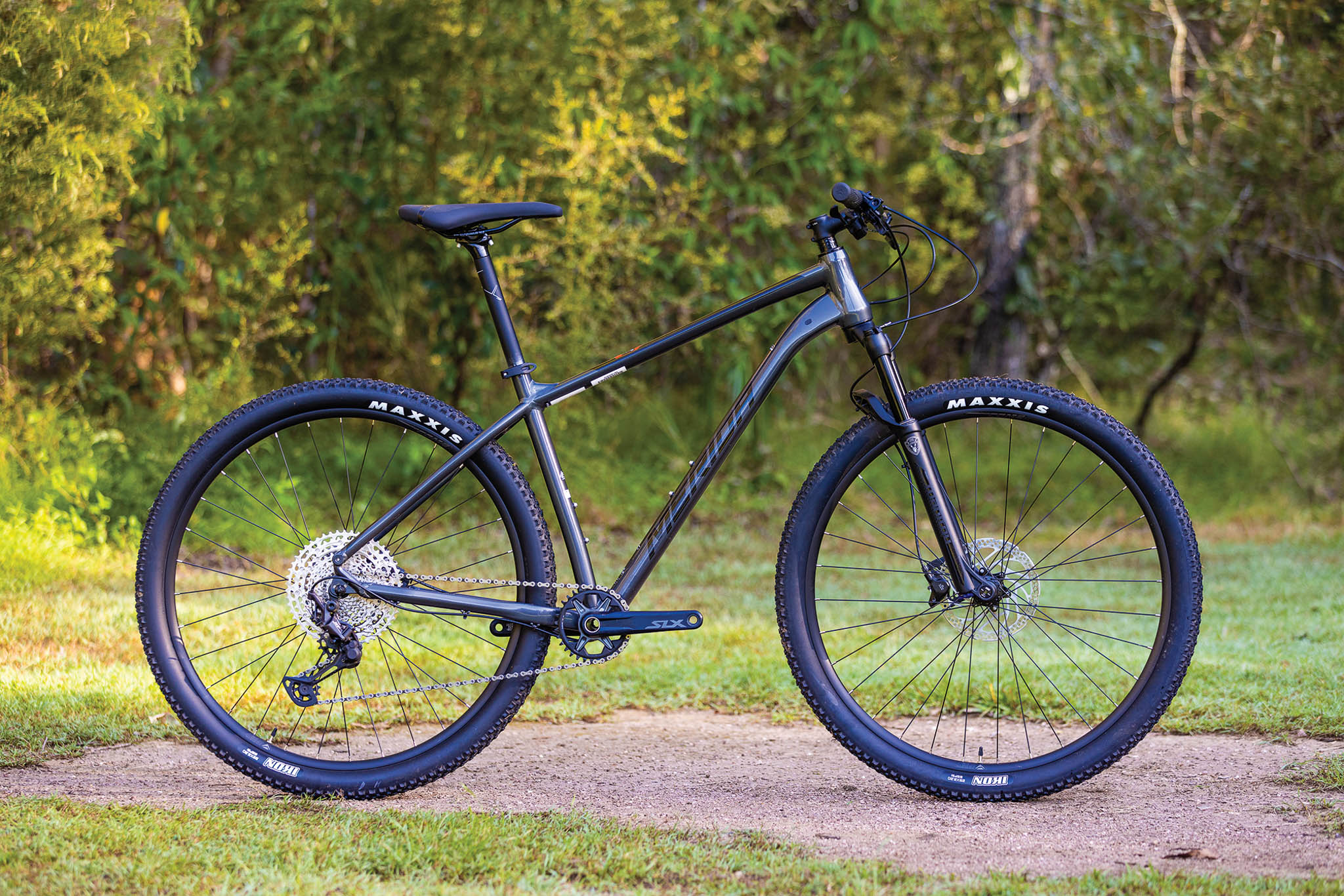
Norco Fluid HT 2 – $1699
Tester: Hayden Wright
Norco’s Fluid HT range is their self proclaimed ‘ultimate singletrack adventure hardtail’. Building off their well known Fluid moniker, this hardtail variant promises to deliver a boundless riding experience at a competitive price point. Distributed nationally by Advanced Traders, you can get your hands on one of these Canadian freedom machines in store at one of their chosen dealers around the country.
Features of the Norco Fluid HT 2 Hardtail
This HT 2 is the more affordable of the two Fluid HT models which Norco offers. They both share the same specification for the vast majority, including the frame. Featuring internal cable routing, 5 size options across two wheel diametres, Boost spacing, and those beautiful welds which Norco are well known for, this frame is a fine piece of aluminium to say the least. On the front end, it is supported by a 120mm SR Suntour coil sprung fork which has rebound and preload adjustments. Drive is taken care of by a Deore 5100 series 11 speed Shimano drivetrain, which includes a wide range cassette and two piece crank. The HT 2 also comes with a dropper seat post, which has 130mm of drop across all sizes.
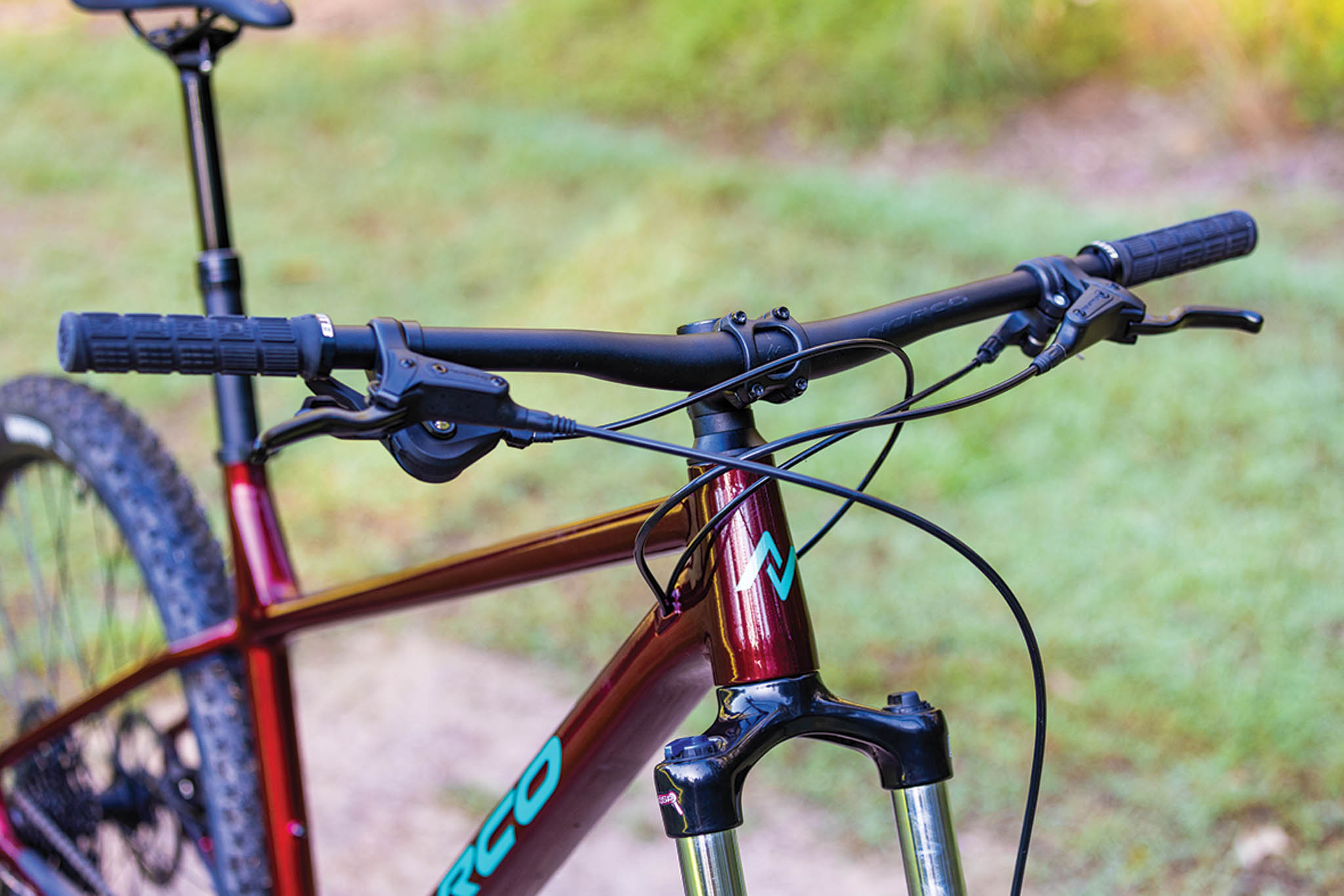
Geometry and Handling
Perusal of the specification sheets for the Fluid HT 2 brings with it geometry numbers which are expected for a mid travel trail hardtail. The head tube angle is right on the money at 66.5°, which strikes a nice balance between stability at speed without sacrificing too much low speed handling. While hardtail head tube angles do steepen quite a bit during aggressive riding, this wasn’t the case on the Norco – more on that later. Similarly, the seat tube angle on a hardtail will also steepen under sag. This puts the 74.5° STA on the Fluid right on the money for this application, delivering a fairly upright riding position when paired with a 500mm reach and 637mm stack height on the XL. As we can expect with a Norco, the rear end is short at 430mm. This does give the bike a very playful character, further reinforcing the overall ride quality this bike brings – fast and fun.
Ergonomics
The contact points on this bike, while all being components I am not familiar with, were impressive. A gold star has to go to the saddle. It is comfortable, has a smooth profile and suited my sit bones so well I may actually look at speccing these on my own personal trail hardtail. Similarly, I really liked the profile and compound of the WTB lock on grips. They had just the right amount of cushion for my hands, and no outer lock rings which is always nice. The Fluid comes with a 50mm stem and 750mm bar which to me are the perfect combination for a trail hardtail. I felt right at home, but some riders may prefer something a little wider. It would be good to see Norco specify something in the region of 800mm, allowing for a quick chop to really dial in the cockpit fit.
Components
This was my first experience with the 11 speed Shimano Deore 5100 drivetrain. It provided more than enough range and a reliable shift, which we have come to expect from all Shimano group sets of late. I was surprised to see a 175mm crank on the larger models, but honestly that was little more than a number in the back of my head once I took to the trails. Similarly, the 2 piston Tektro brakes had good lever feel and enough braking power to keep me out of trouble during testing. The 180mm front rotor is also a nice touch, adding some additional stopping power and modulation. TransX’s 130mm dropper worked well, but did not have enough drop for my liking. When swapping between bikes I would find myself constantly hitting my rear against the seat while descending. It would have been good to see at least 150 mm of drop if not more, similar to what the Giant and Trek offer.
One could argue that on a hardtail, fork performance is at an absolute premium. As such, I was disappointed by the performance of the SR Suntour XCM32. The coil spring offers little in the way of rate adjustment, and the bushings are loose like a wizard’s sleeve out of the box. The fork does do well at absorbing single hard hits, but any repeated chatter was being transmitted straight to my arms rather than being soaked up by the suspension. Similarly, I was surprised to see cup-and-cone hubs on a bike this capable. During testing they did require adjustment which had me questioning their long term durability.
Fun Factor on the Trail
Norco has fostered an eclectic mix of chassis stiffness, playful geometry and a brutish overall nature with the Fluid HT 2 that just screams “go faster” to me. I do think the (lack of) fork performance does add to this character, making me want to grit my teeth and go hell for leather knowing that my line choice may have little effect on chassis performance. In this instance, the bike’s heavy overall weight is actually welcome. The burly wheels, heavy fork and stiff frame all add up to give a stable and predictable ride across any terrain when combined with the 2.4” Maxxis tyres. The consistent front end ride height makes the Norco feel slacker than it actually is, which also breeds confidence on steeper terrain if you’re brave enough to hold on.
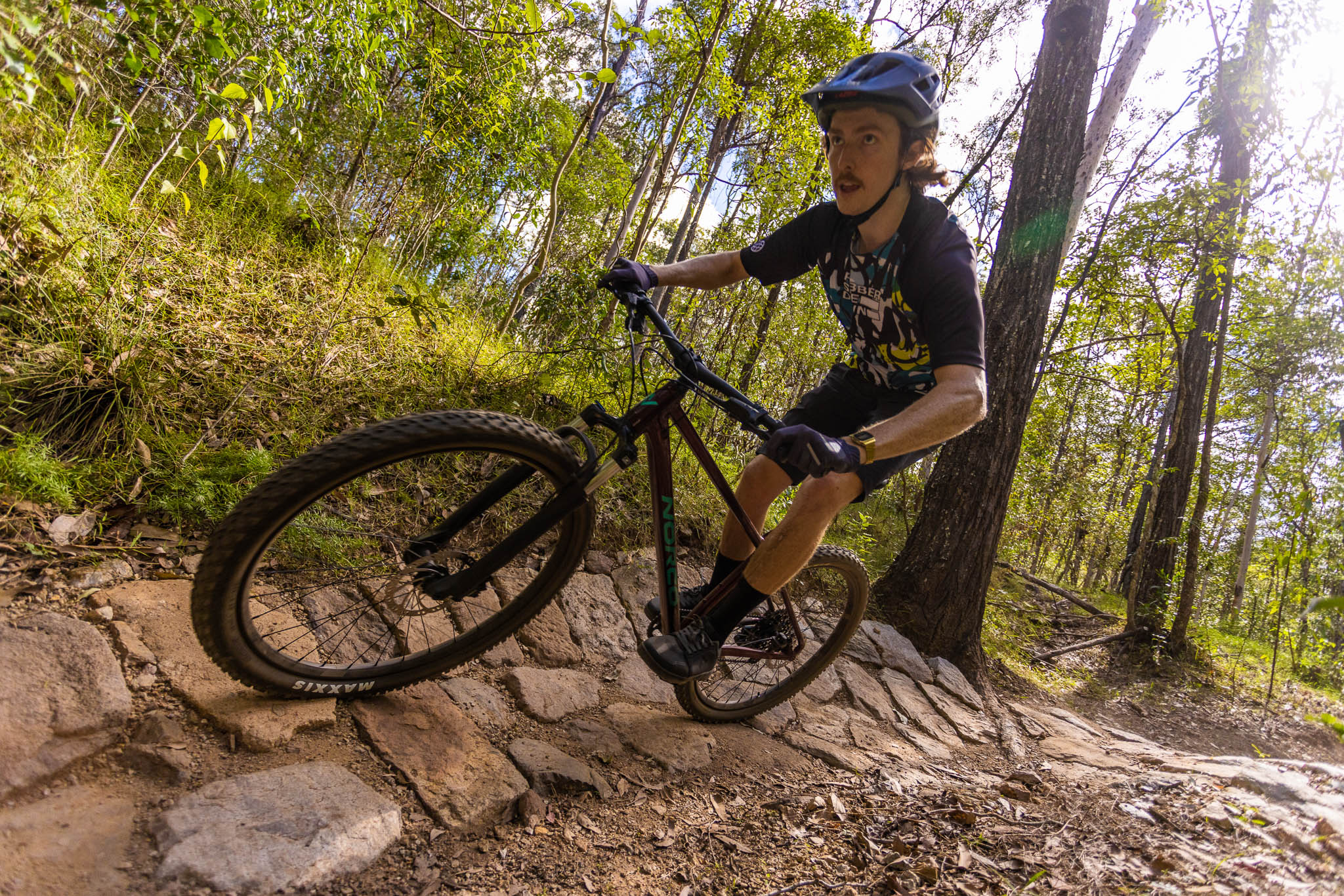
On the way back up the trail the Fluid provided a comfortable riding position and sharp shifting. The Shimano drivetrain shifts well under load and still provides a full 51t granny gear even though it is an 11-speed group set. As mentioned earlier, the seat is a lovely thing to rest upon and I could happily spin away for hours on this bike, be it on a leisurely trail ride or marching my way back up for another spicy descent.
Our Take on the Norco Fluid HT2
Of the three more trail-oriented budget mountain bikes we have on test here, the Norco is definitely the one that would ride with a speaker blasting Metallica out loud, encouraging others to join it on its next wild adventure. This bike is tough, capable, and has handling that is a little rough around the edges. I think it would best suit an exuberant rider who is looking for their first foray into mountain biking, regardless of age. The bike’s character is supported by a dependable drivetrain and brakes, and the frame quality is more than worthy of long-term use and upgrades. If you want something a little flashier, the HT 1 sells for $1999, and gains an air spring Suntour fork, and Shimano 12-speed components.
Best hardtail mountain bikes under $2000
Marin Team 1 – $1999
Trek Marlin 8 – $1899.99
Merida Big.Nine SLX – $1999.99
Norco Fluid HT2 – $1699
Cube Attention SL – $1799
Reid Tract 4 – $999.99
Giant Fathom 2 – $1899
Cannondale Trail SL 4 – $1899
All parts and specifications overview
SPECIFICATIONS
Norco Fluid HT 2
RRP $1699.00
Weight 15.5kg (XL)
From advance traders.com.au
Available Sizes XS, S, M, L, XL (Tested)
Wheel Size 27.5” (XS-M), 29” (M-XL)
Frame Material 6061 Aluminium
Fork SR Suntour XCM32 LOR DS, 120mm Travel
Shifter Shimano Deore SL-M5100 11sp
Derailleur Shimano Deore RD-M5100 11sp
Crank Shimano Deore FC-M5100-1, 30T, 170mm (XS,S), 175mm (M-XL)
Bottom bracket Shimano Sealed Bearing BSA Threaded
Chain KMC X11
Cassette Shimano Deore CS-M5100, 11sp, 11-51T
Hubs Alloy, 6 bolt, 32h, Boost
Spokes Stainless, black
Rims Alex DP30 TRS
Tyres Maxxis Ardent 2.4” EXO
Brakes Tektro HD-M275 Hydraulic , 180/160mm rotors
Stem Alloy, 50mm, 31.8 Clamp
Handlebars X6 Alloy, 750mm wide, 15mm rise
Seatpost TransX YSP18 Dropper, 130mm drop
Saddle Norco XC
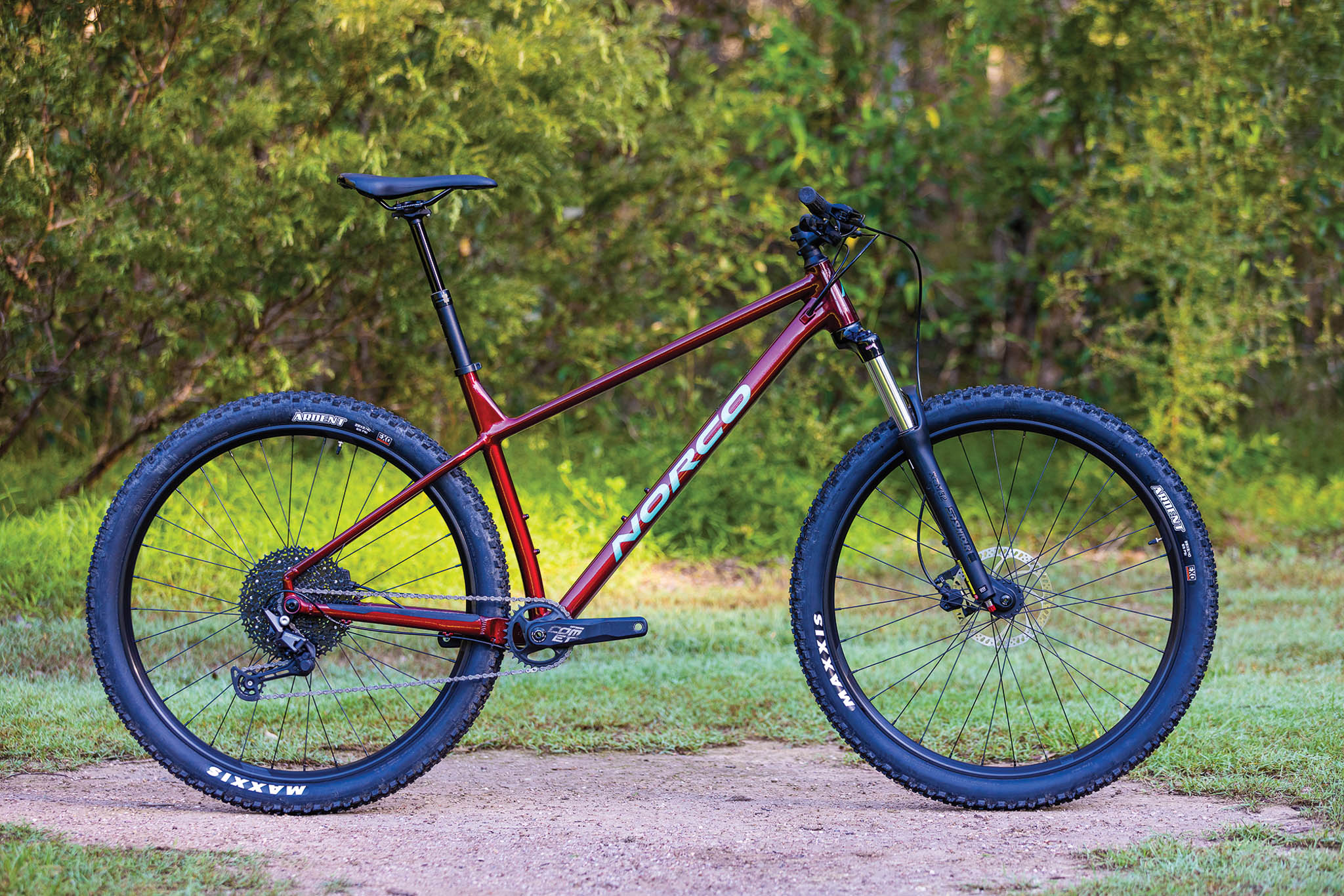
Cube Attention SL – $1799
Cube Bikes are sold exclusively at 99 Bikes in Australia, so you’re always likely to find good levels of stock on the shop floor. Hailing from Germany, Cube have an extensive line up of bikes, from hybrids, to speedy road bikes, high zoot e-bikes, and entry level hardtails like the Cube Attention SL here. The Attention SL is a contemporary entry level XC 29er hardtail, with a great build kit and nicely finished frame. 99 Bikes say that with the Attention SL, you’ll grow in confidence before you know it.
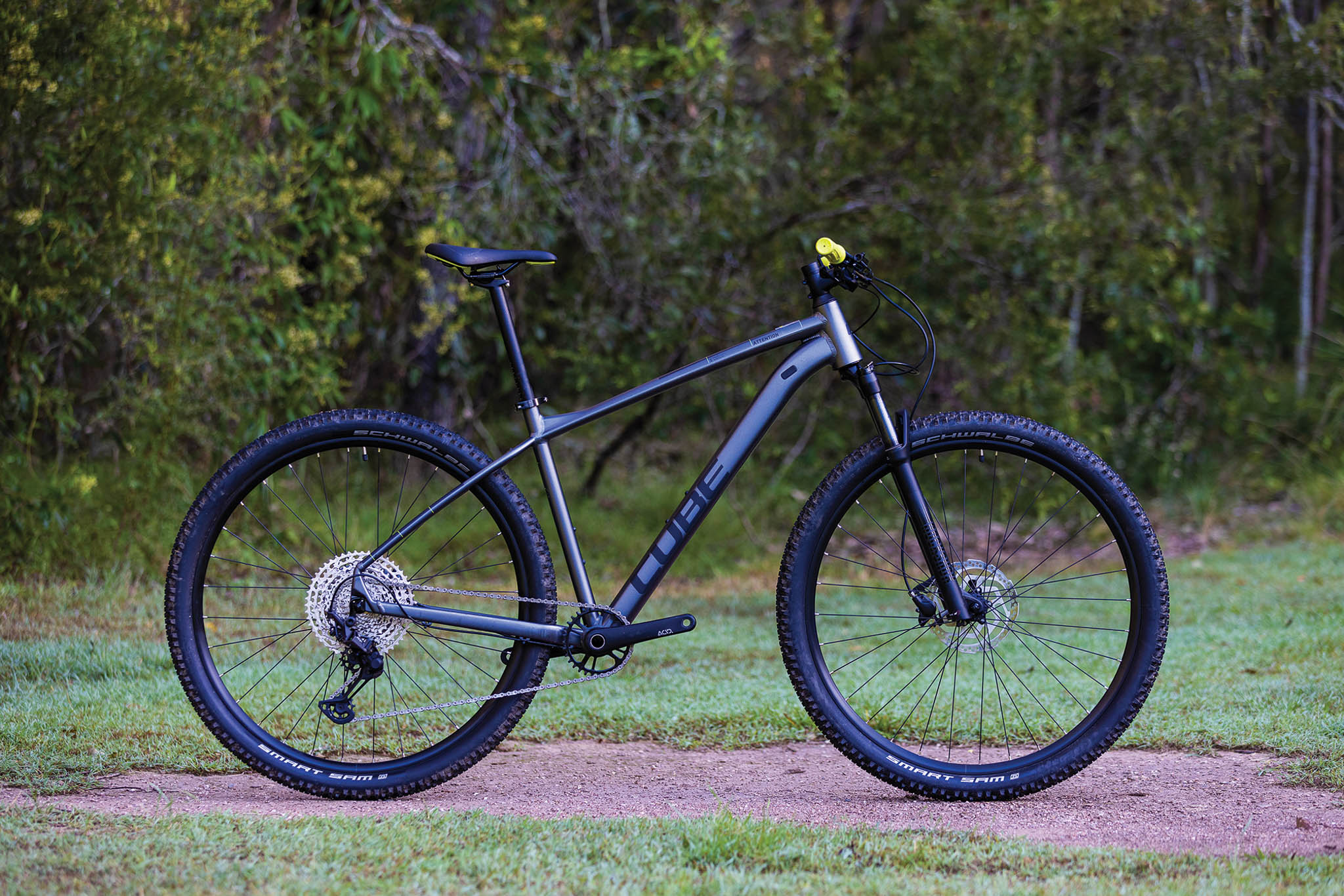
Features of the Cube Attention SL
This is a really nice frame, with double-butted alloy tubing to help keep the weight down and the strength high. It has a good stand over height and comes in 6 sizes, with XS and S using 27.5” wheels. The tapered head tube meets a large down tube with internal routing, including room for a dropper post if you chose to add one later. The externally threaded bottom bracket will be reliable, and the frame has plenty of clearance around the 2.25” tyres. Cube equip the Attention SL with a remote lock out, air sprung Judy from RockShox, and add a group set mixing Shimano Deore, SLX and even XT 12-speed parts. The eyeletted rims attach to quick release hubs front and rear.
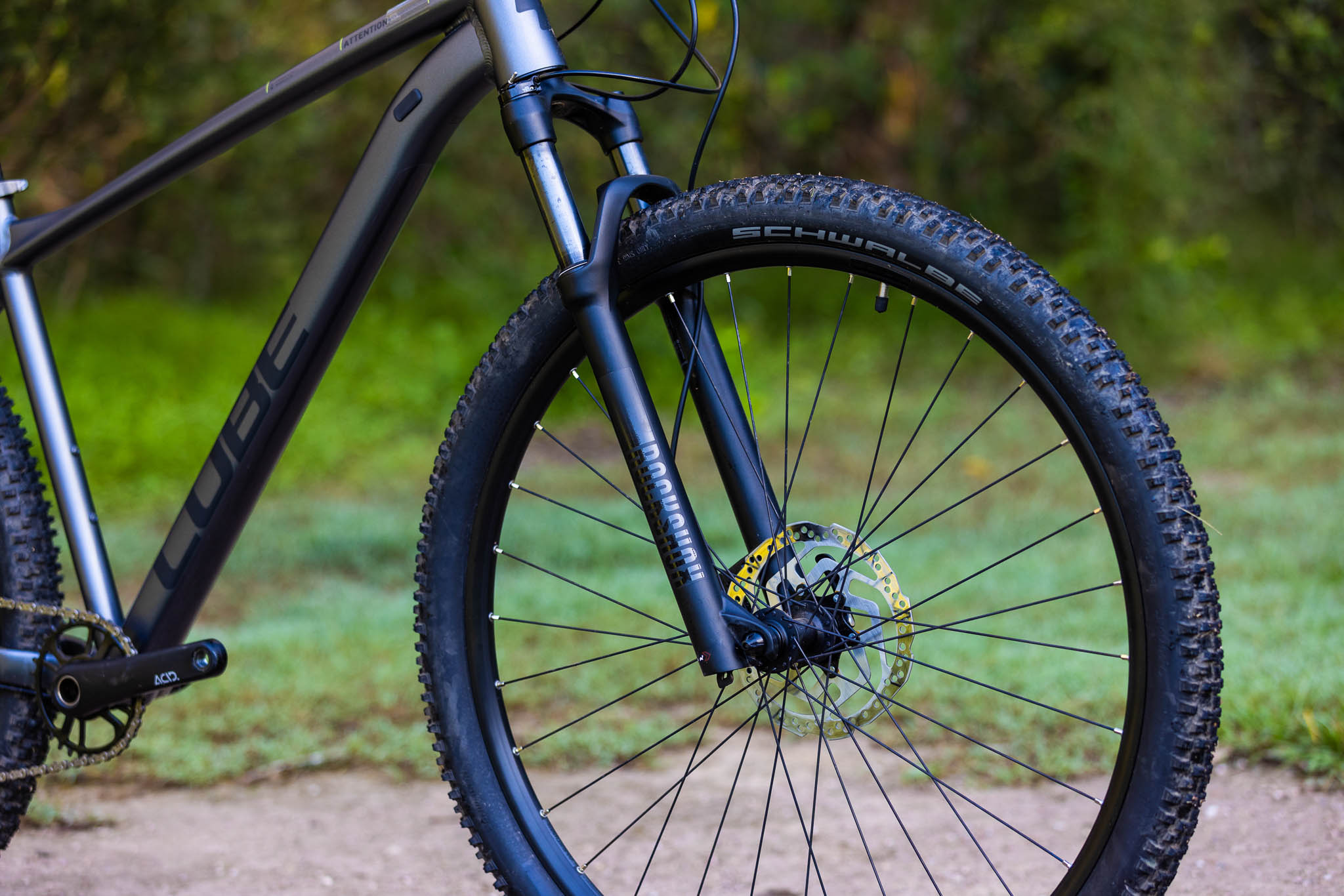
Geometry and Handling
The geometry on the Cube is what you’d expect for a well built entry level hardtail, focusing on balance and easy handling. The Cube Attention SL has a 68.5 degree head angle and 73.5 degree seat angle in the large on test, and the reach is just under 430mm. With a short stem and fairly narrow 680mm bars, the bike rides a little smaller than you’d think – but it is pleasingly nimble. Of note, the bike didn’t leave me feeling beat up like a couple of the heavier bikes on test, with a fairly resilient ride. It’s a very well-balanced position, and the quick release seat post is a nice inclusion for dropping the saddle quickly when needed.
Ergonomics
I was happy with all the contact points on the Cube Attention SL. From the grips, to the common MT 200 brake levers and Deore shifter. The RockShox Poploc remote is easy to setup right next to the left brake lever for easy access to the suspension lock-out. While the short stem was a good fit, I did find the low rise bars just too narrow at 680mm. They’ll suit cruising on bike paths, but for anyone around 175-180cm who would be eyeing off this bike, I think they may prefer something in the 730-760mm range for a better balance.
Components
Cube have delivered a great mix here for a well-built entry level hardtail. When I still worked at a bike shop, riders always wanted something with easy gears to use, and brakes that worked. Cube deliver that with probably the most comprehensive group set on test, with a Shimano Deore drivetrain and an XT rear derailleur – but also a Shimano Deore chain which works with the Hyperglide+ cassette so you can shift under load better than any other bike on test. The Shimano MT200 brakes work as expected, and RockShox trust suspension to the oldest lady in the game – Judy. The 100mm of air sprung suspension can be set to suit the rider, with rebound damping that works.
While the wheels use a quick release, they’re a nice build with Shimano hubs and eyeletted rims, that let the wheels have good spoke tension. The Schwalbe tyres aren’t a very wide 2.25”, but they have plenty of tread and they’re a robust build.
Fun Factor on the trail
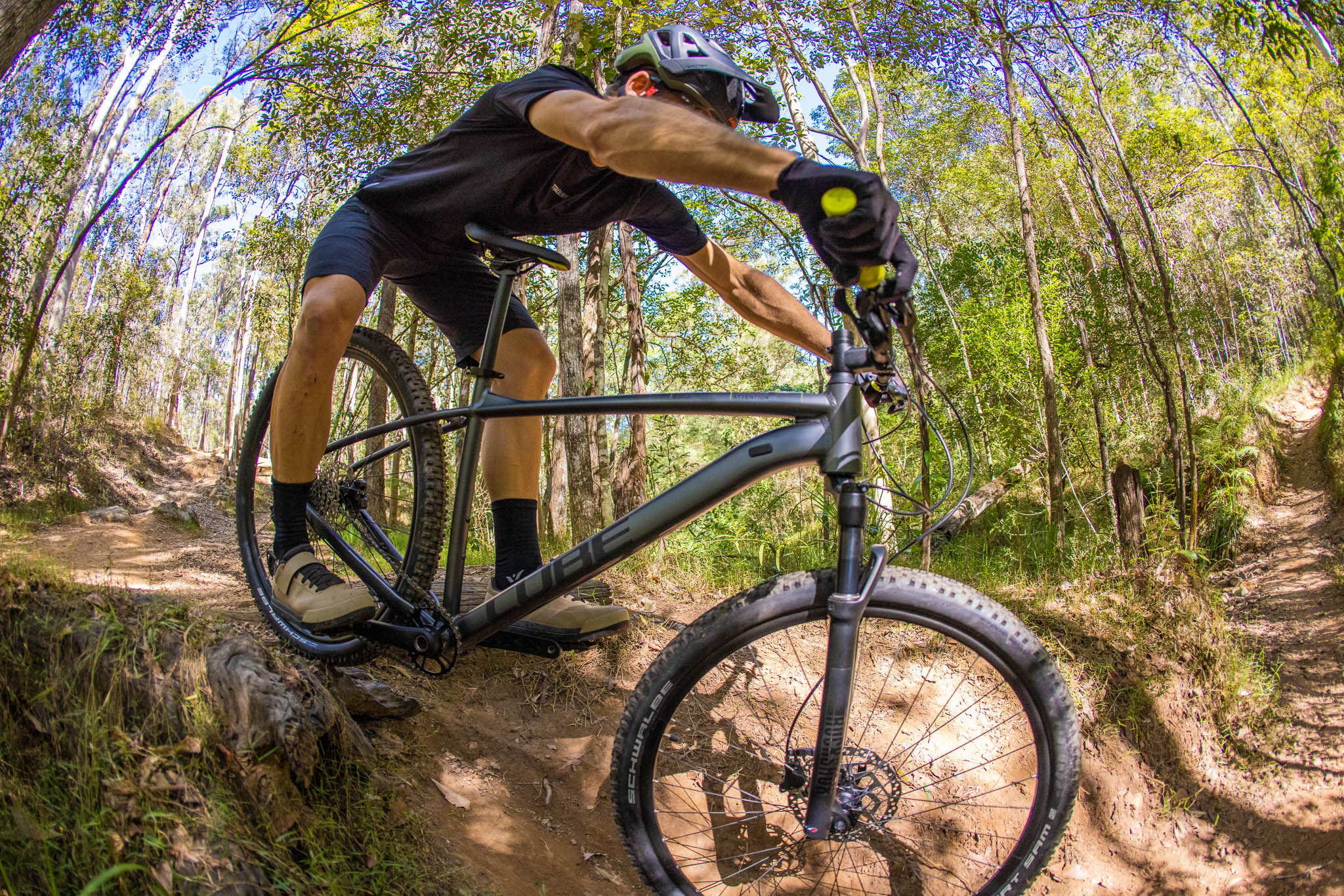
Where the Cube shines is getting out to explore. It’s a dream to tick over the kilometres on. The Cube handles mellow trails with aplomb, and I think there’s a balance for riders between a light handling bike like this that’s easy to handle on flat and smooth trails, compared to a longer and slacker and burlier trail hardtail that really needs the assistance of gravity to come alive.
The Cube playfully pops over features on the trail, and makes short work of climbs and fast corners. It only really starts to come unstuck on extended rough sections, which is where I would have happily had a wider set of bars and wider tyres for a little but more comfort and control. With a steady hand it can handle a lot of intermediate trails, and will be a blast on all but the fastest flow trails, where the higher speeds and compressions may well leave you beyond the limits of traction and stability from the tyres and wheels.
With a low overall weight and seamless shifting, the bike really excels getting out on beginner to intermediate trails. Given all the equipment works so well, the Cube should be a confidence inspiring bike to get on for anyone new to riding off road. It would have been good to see updated through axles front and rear, but I don’t think the quick release is going anywhere yet.
Our take on the Cube Attention SL
The Cube Attention SL has a very balanced build kit, built on a superbly finished alloy frame. It has good geometry for hitting the trails, and modern features like a tapered head tube, internal cable routing, and good tyre clearance for some fatter tyres. The handling is modern XC, and it is perfect for taking to local singletrack that’s smooth and fast, with some low speed technical features. It may not be the best choice for anyone looking to tackle the fast flow trails, jump lines and janky trails at their local. But if you want a fast bike to get out and ride, or load up for a day in the hills exploring – then you’ll likely get on really well with the Cube.
Best hardtail mountain bikes under $2000
Marin Team 1 – $1999
Trek Marlin 8 – $1899.99
Merida Big.Nine SLX – $1999.99
Norco Fluid HT2 – $1699
Cube Attention SL – $1799
Reid Tract 4 – $999.99
Giant Fathom 2 – $1899
Cannondale Trail SL 4 – $1899
All parts and specifications overview
SPECIFICATIONS
Cube Attention SL
RRP $1799
Weight 13.77kg
From 99bikes.com.au
Available Sizes XS, S, M, L (tested), XL, XXL
Frame Material Double butted alloy
Fork RockShox Judy Silver TK Air, 100mm
Shifter Shimano Deore 12sp
Derailleur Shimano Deore XT 12sp
Crank ACID 2 piece, 32t, 175mm
Bottom bracket Shimano BSA external sealed
Chain Shimano M6100, 12sp
Cassette Shimano Deore 12sp 10-51t
Hubs Shimano MT401, 32h, QR
Spokes 14g stainless, black
Rims Cube ZX20 alloy, 32h
Tyres Schwalbe Smart Sam Active, 29 x 2.5””
Brakes Shimano MT200, 180/160mm rotors
Stem Cube alloy, 70mm
Handlebars Cube flat bar, 680mm wide
Seatpost Cube alloy, 27.2mm
Saddle Natural Fit Venec Lite
Reid Tract 4
Tester: Mike Blewitt
Reid Bikes have carved a niche in the Australian market by offering exceptional value for the budget conscious mountain biker. We have tested a number of their budget mountain bikes over the years, and always been impressed with the ride quality and features that Reid can put together at the price the bikes hit the floor at. The Tract range of bikes are 29er hardtails with 120mm travel forks – a perfect gateway into the world of riding off-road. Reid call the Tract 4 a value monster, and at $1000 with a 12-speed group set they’re spot on.
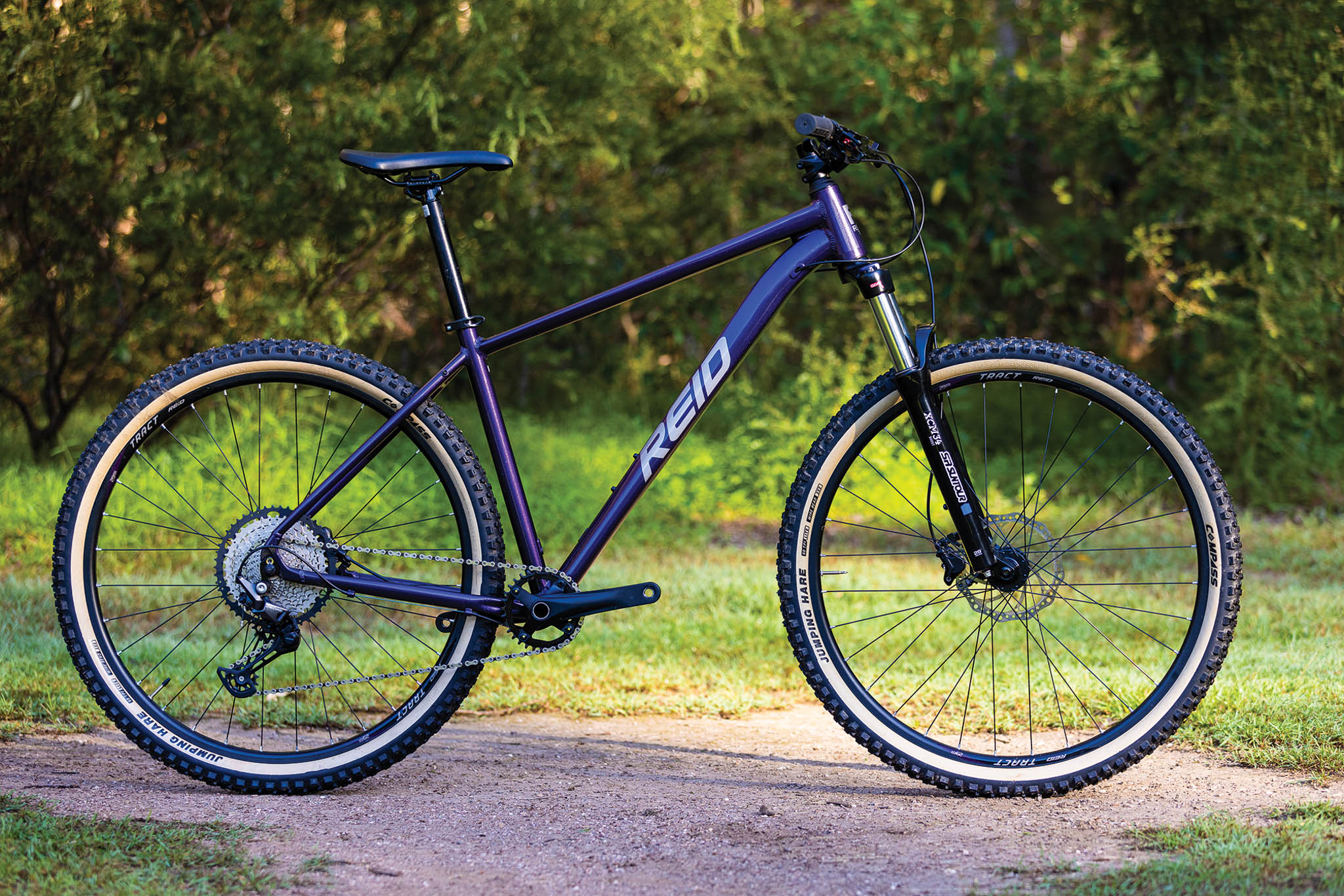
Features of the Reid Tract 4
The alloy frame has internal cable routing, and a sturdy 34mm legged, coil sprung Boost spaced suspension fork. Kudos to Reid for getting a 12-speed group set on here for simple shifting across a wide gear range. It’s also impressive that they have hydraulic brakes at this price point. There is routing for an internal dropper post, but one is not included at this price. The frame uses a quick release rear wheel, and there are bolts for a single bottle on the down tube.
Geometry and Handling
Reid have a 68 degree head angle and 74 degree seat angle on this large test bike. The reach isn’t listed, but the 637mm top tube and feel would suggest around 450mm. The head tube isn’t overly tall but with spacers, the upright stem and 30mm riser bars, you end up with a pretty high position – something anyone new to riding will likely really enjoy. The steering is far from nervous with the 120mm fork and steady 68 degree head angle, although a little more emphasis is needed in the stock high position, to load up the front wheel to keep it gripping.
Ergonomics
I really like the bike length when seated, however the riser bars are just too narrow for a large sized bike. It seems like a small quible, but the length of the frame and a short stem are designed to go hand in hand with a wide bar. It’s an easy change, and the spec sheet lists a 740mm bar so hopefully it was just our sample. Apart from that, the levers offer reach adjust and the shifter falls nicely at hand; the saddle is comfortable, and it’s easy to run the bars high as stock, or lower it for a more purposeful stance.
Components
The Reid Tract 4 has managed to bring some great features together for $1000. The 120mm travel, 34mm legged Suntour fork is a nice touch. It has lock out and spring preload, but no option to change the spring rate or rebound. The Shimano Deore 12-speed components are a bonus, and although the spec list online lists a Shimano 12-speed cassette, we have a slightly narrower range Suntour model fitted. It shifted fine, and the replaceable chain ring on the two-piece cranks is a good touch. The tyres have a full tread and a reasonably firm stout casing; there were no issues on test for the tyres or wheels.
Fun Factor on the trail
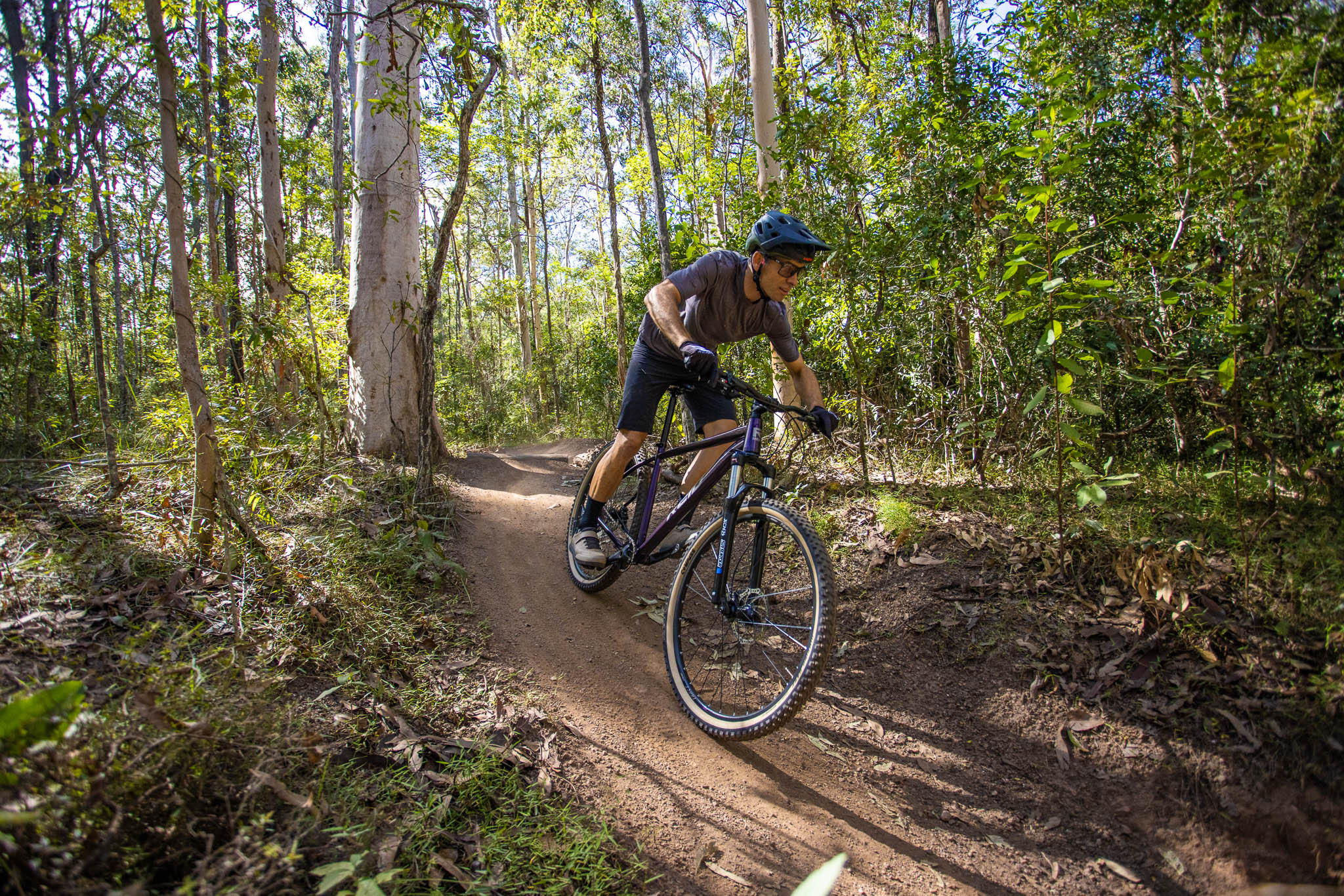
At over 15kg, the Reid charges ahead like a battleship on the trails. The upright position and reach makes for a comfortable ride, although the narrow bars do impact the overall comfort and stability when moving faster. Compared to some of the other hardtails I tested, there was no sense of nervousness at higher speeds on fast flow trails, like some of the test trails that we used which have had a recent refurbishment. But given the stout nature of the frame and fork, the built rock gardens that are common in purpose built trails were bone rattlers.
The Reid was surefooted in corners, and the reasonably long wheelbase even tracked well on off-camber corners, with more stability than you might expect for a $1000 hardtail. I was pretty wary dropping into moderate trails with extended rocky sections, but on compressions and single drops or hits the bike is still really capable. The suspension fork just holds it back from being able to recover for repeated impacts, and that impacts control and fun. Additionally, while the brakes were adequate, they never truly achieved the power I was expecting from a hydraulic system like the others on test.
Our take on the Reid Tract 4
About 5 years ago I tested a Reid gravel bike for about $900, and questioned how much fun you could have on a bike under $1000. I had a tonne of fun riding that bike, and the Reid Tract 4 is no different in that sense. It’s a two wheeled adventure machine that is ready to let someone go and explore the world of riding off-road. Be that dipping your toes into singletrack, checking out the local multi-use trails or exploring a rail trail – that’s up to you. But, there really is no mystique between a bike at $1000 and $2000, the one twice the price will have components that will work better. I like that the Reid gets people on the dirt with some great features, and with a couple of tweaks it should be a great long-term off-road adventure bike for a those looking for a great value buy.
Best hardtail mountain bikes under $2000
Marin Team 1 – $1999
Trek Marlin 8 – $1899.99
Merida Big.Nine SLX – $1999.99
Norco Fluid HT2 – $1699
Cube Attention SL – $1799
Reid Tract 4 – $999.99
Giant Fathom 2 – $1899
Cannondale Trail SL 4 – $1899
All parts and specifications overview
SPECIFICATIONS
Reid Tract 4
RRP $999.99
Weight 15.42kg
From reidcycles.com.au
Available Sizes 38cm, 43cm, 48cm (tested), 53cm
Frame Material 6061 Aluminium alloy
Fork SR Suntour XCM 34 Boost, 120mm
Shifter Shimano Deore 12sp
Derailleur Shimano Deore 12sp
Crank Prowheel Charm, 175mm, 32t
Bottom bracket BSA external sealed
Chain KMC X12
Cassette Sunrace 12sp 11-50t
Hubs 32h alloy, sealed bearing, 6 bolt
Spokes 14g stainless, black
Rims Reid 29″ Double wall
Tyres Compass Jumping Hare 29×2.2″
Brakes C Star hydraulic, 180/160mm rotors
Stem Reid Alloy
Handlebars Reid Alloy 30mm riser, 680mm
Seatpost Reid alloy, 30.9mm
Saddle Selle Royale
Giant Fathom 2
You’ll have to excuse me as I rummage through the kitchen junk drawer for my rose tinted glasses before writing this review. I, like many of you reading this, grew up on and around affordable Giant hardtails. While the Taiwanese heavyweights of industry did take a sabbatical from this genre of bike through the early to mid 2010’s, they’re now back with bikes like this Fathom 2 that we have on test. But how does this 29er trail hardtail hold up against the other budget mountain bikes on test? Can it capture the blissful reliability of its predecessors? And what about the performance of that Giant branded fork? I was keen to find out.
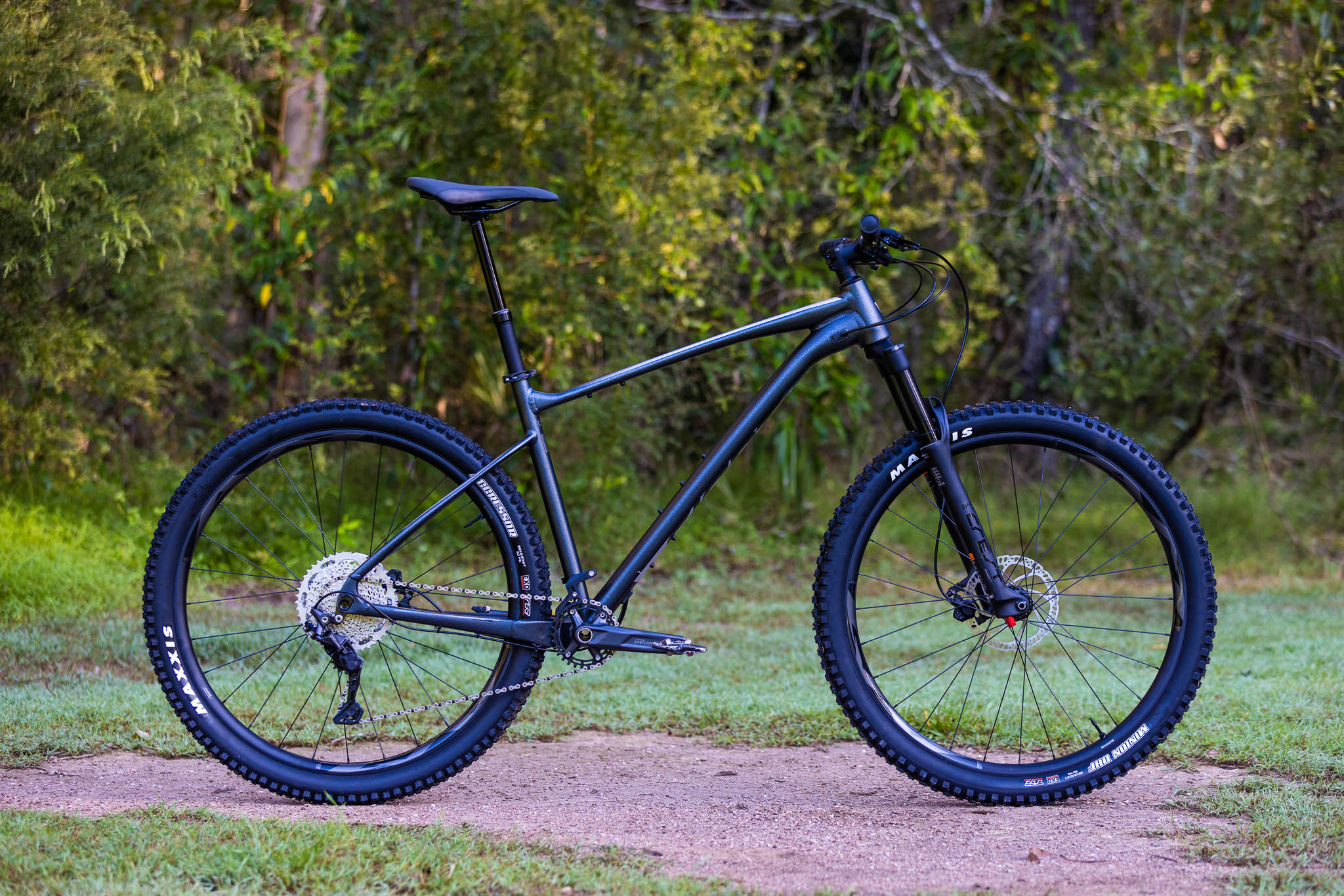
Features of the Giant Fathom 2
The Giant Fathom 2 shares almost the exact same specification of the slightly more expensive 1 model, excluding the drivetrain and brakes. Boost spacing front and rear, a dropper post, wide Maxxis tyres and a 130mm fork firmly place it in the ‘trail’ category – but further inspection shows a few interesting spec choices. First of all, drive is handled by a 10 speed Shimano group set which we rarely see here at AMB, lacking the range of the comparatively priced Trek and Norco. Second, the fork is house brand and while it has rebound, compression and air spring adjustments, it is unproved to our testers and carries with it little information on servicing and maintenance.
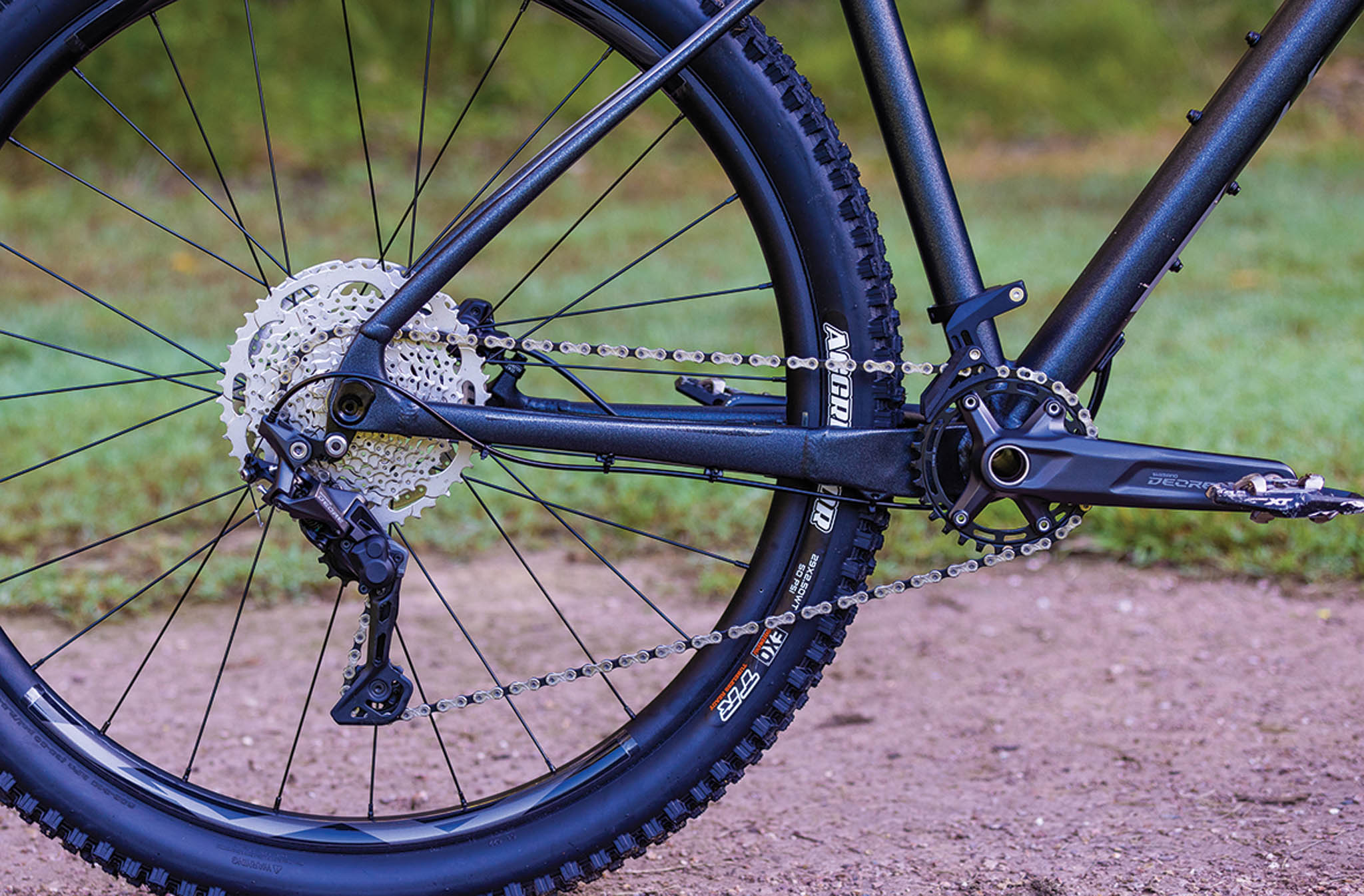
Geometry and Handling
Across all four sizes the Fathom has a 66 degree head tube angle, 75 degree seat tube angle and 438mm chain stay length. This, when paired with the 490mm reach on the XL test bike we had on hand led to a ride quality that was both comfortable and confidence inspiring. The angle of the seat tube gave a very comfortable climbing position, without putting too much weight on my wrists on flatter pieces of trail. Similarly, the head tube angle felt just right for this style of bike, giving a good mix of performance regardless of the gradient of the singletrack I was riding. The boost axles front and rear, 34mm fork, wide rims and thick Maxxis rubber all meshed well with the frame geometry to provide a ride which was stiff without being uncomfortable or chattery. The only letdown for the handling of this bike was the 700mm wide bar and thick soft grips. Being narrower and softer than what I expect, my upper body was forced into a riding position which was too narrow and lacked precision. This was the only letdown to an otherwise great handling package.
Ergonomics
As mentioned above, it was immediately obvious that the handlebars and push on grips hamstrung the performance of this otherwise very capable bike. The width of the bar led to a lack of leverage, particularly mid turn and when trying to jump or manual. When combined with the push on grips, which had a tendency to twist and squirm when I was really trying to push on the descents or sprint hard, you had what I feel was a real let down ergonomically. If you are looking to get your own Fathom, I would highly recommend you include the purchase of an aftermarket bar / grip combo before you roll the bike off the showroom floor.
Components
At this price point, manufacturers have some tough decisions to make regarding the components specification of their hardtail mountain bikes. Do they go in the middle of the road across the board, like on the Trek? Do they focus on the drivetrain, like we see on the Merida? In this case, Giant chose to focus on the fork and wheels, both of which are the highest performing across the three trail hardtails on test. If I had a blindfold on, I’d say that the lesser known Giant Crest 34 fork was a Fox Float. It had a smooth action, plenty of adjustment and little chassis flex leading to what I felt to be the best fork on test. The 30mm wide alloy wheels are also great performers, coming tubeless ready and with sealed bearing hubs – these hoops should give you years of faultless service. To allow for this choice in wheels and fork, Giant have gone with a lower specification 10 speed Shimano drivetrain. Shifts were crisp and the inclusion of a front guide ensured no dropped chains during testing, but this transmission definitely lacked the range and smooth steps of the other 11 and 12 speed drivetrains we’ve been using.
Fun Factor on the Trail
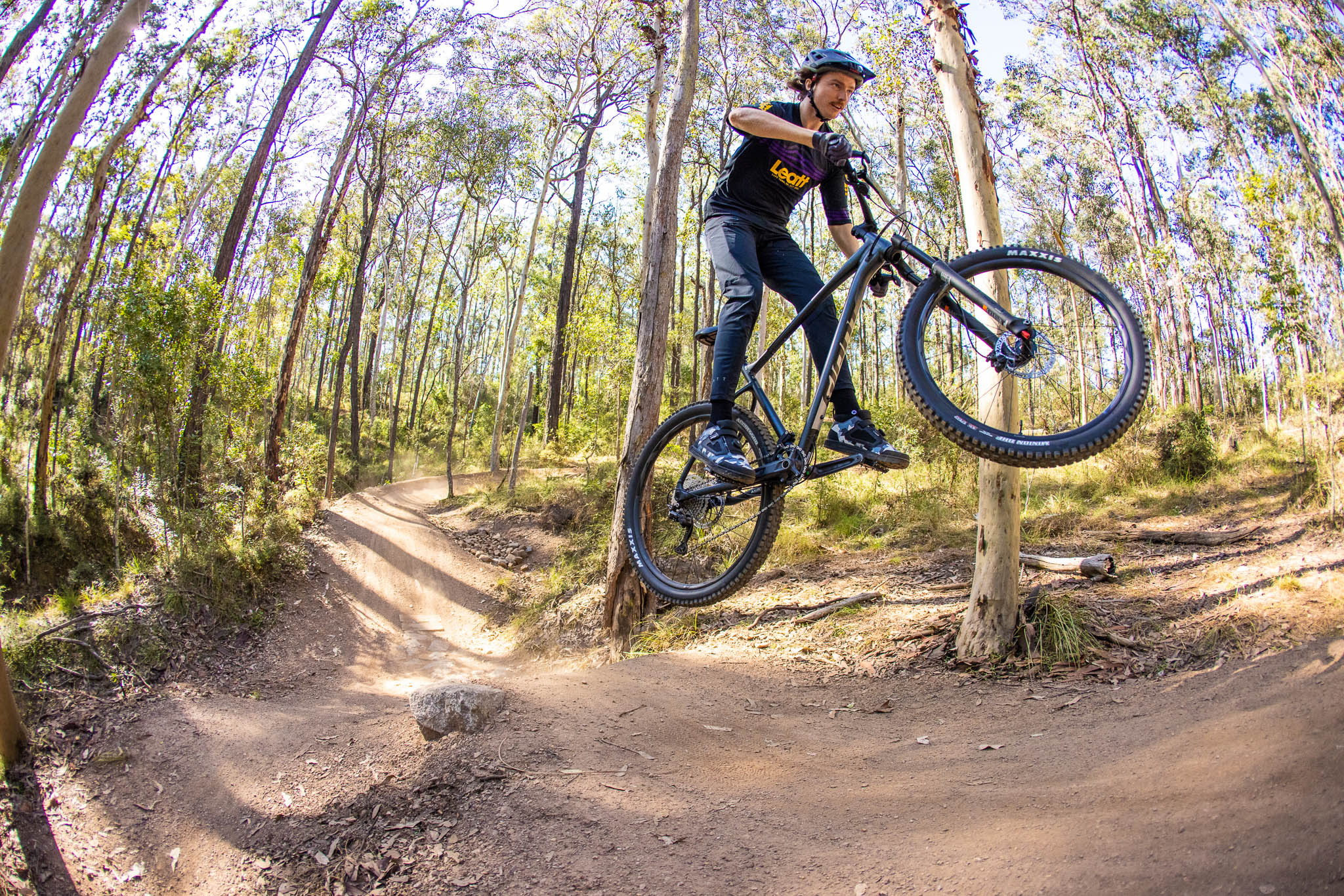
This bike put a smile on my face, plain and simple. Once I became familiar with the narrow handlebar, the Fathom became an absolute blast to ride. There were no quirks or surprises with its performance, leaving my mind free to just focus on the dirt in front of me with no distractions. The Minion DHF and Aggressor tyre combo gave gobs of traction, with the age-old combo of grippy on the front and fast on the rear lending itself to lots of drifts and skids on my loose test loop. The 170mm dropper post specced on this XL model further bolstered this positive trait, as I was able to get the seat right down and out of the way when things started to get a little wild. Fork performance was second to none on the test, further lending me to believe this bike was the best descender we had across the 8 hardtails we rode. Having the ability to dial in the spring rate, compression and rebound to my liking on a fork that is stiff and smooth is a real treat at this price point. Climbing performance was comfortable, although the decreased gear range and large step to the smallest cog does leave some performance to be desired from the 11 and 12 speed group sets seen on comparable bikes.
Our Take on the Giant Fathom 2
This 29er hardtail from Giant definitely recaptures the fun of old. Their decision to prioritise a quality fork and wheel set culminates in a bike which is an absolute joy to ride regardless of if you are going uphill or down. While I feel a few minor upgrades are required to really unlock the true potential of this bike, it still gives a high quality riding experience in stock trim. Those who are looking for a wider range drive train could opt for the Fathom 1 model, but to me that money is better spent on a new cockpit as the two models share the same high quality Maxxis tyres and Giant brand fork/dropper/wheels. The Fathom hardtail is best suited to a rider who is looking for a reliable bike which is a blast to ride on a wide variety of singletrack from green to black diamond.
Best hardtail mountain bikes under $2000:
Marin Team 1 – $1999
Trek Marlin 8 – $1899.99
Merida Big.Nine SLX – $1999.99
Norco Fluid HT2 – $1699
Cube Attention SL – $1799
Reid Tract 4 – $999.99
Giant Fathom 2 – $1899
Cannondale Trail SL 4 – $1899
All parts and specifications overview
SPECIFICATIONS
Giant Fathom 2
RRP $1899.00
Weight 13.5kg (XL)
From giant-bicycles.com/au
Available Sizes S, M, L, XL (Tested)
Frame Material ALUXX SL-Grade Aluminium
Fork Giant Crest 34RCL, 130mm Travel
Shifter Shimano Deore SL-M4100
Derailleur Shimano Deore RD-M5120
Crank Shimano Deore FC-M5100-1, 30T
Bottom bracket Shimano Sealed Bearing BSA Threaded
Chain KMC X10
Cassette Shimano Deore CS-M4100, 10sp, 11-46T
Hubs Alloy, 6 Bolt, 28h, Boost
Spokes Stainless Black
Rims Giant AM29, 30mm internal
Tyres Maxxis Minion DHF 2.5” EXO TR, Maxxis Aggressor 2.3” EXO TR
Brakes Tektro HD-M275 Hydraulic, 180mm rotors
Stem Giant Contact SL 35, 50mm
Handlebars Giant Contact SL TR35, 700mm wide
Seatpost Giant Contact Switch 170mm (XL)
Saddle Giant Romero
Cannondale Trail SL 4
Tester: Mike Blewitt
Cannondale have a history steeped in alloy hardtail mountain bikes. The brand were proudly made in America for decades, equipping pro teams at the highest tier of bike racing on the road and off, forging a place for American manufacturing in a Euro-centric sport that was starting to shift manufacturing to Asia. They even made motorbikes for a little while! These days, Cannondale’s growth has expanded in each direction: in premium mountain bikes and budget hardtail mountain bikes as well. The Trail SL 4 is one of 10 bikes in a range from $829 to $2999. The Trail SL models are designed for faster rides, and the Trail SE models have longer travel forks and burlier builds.
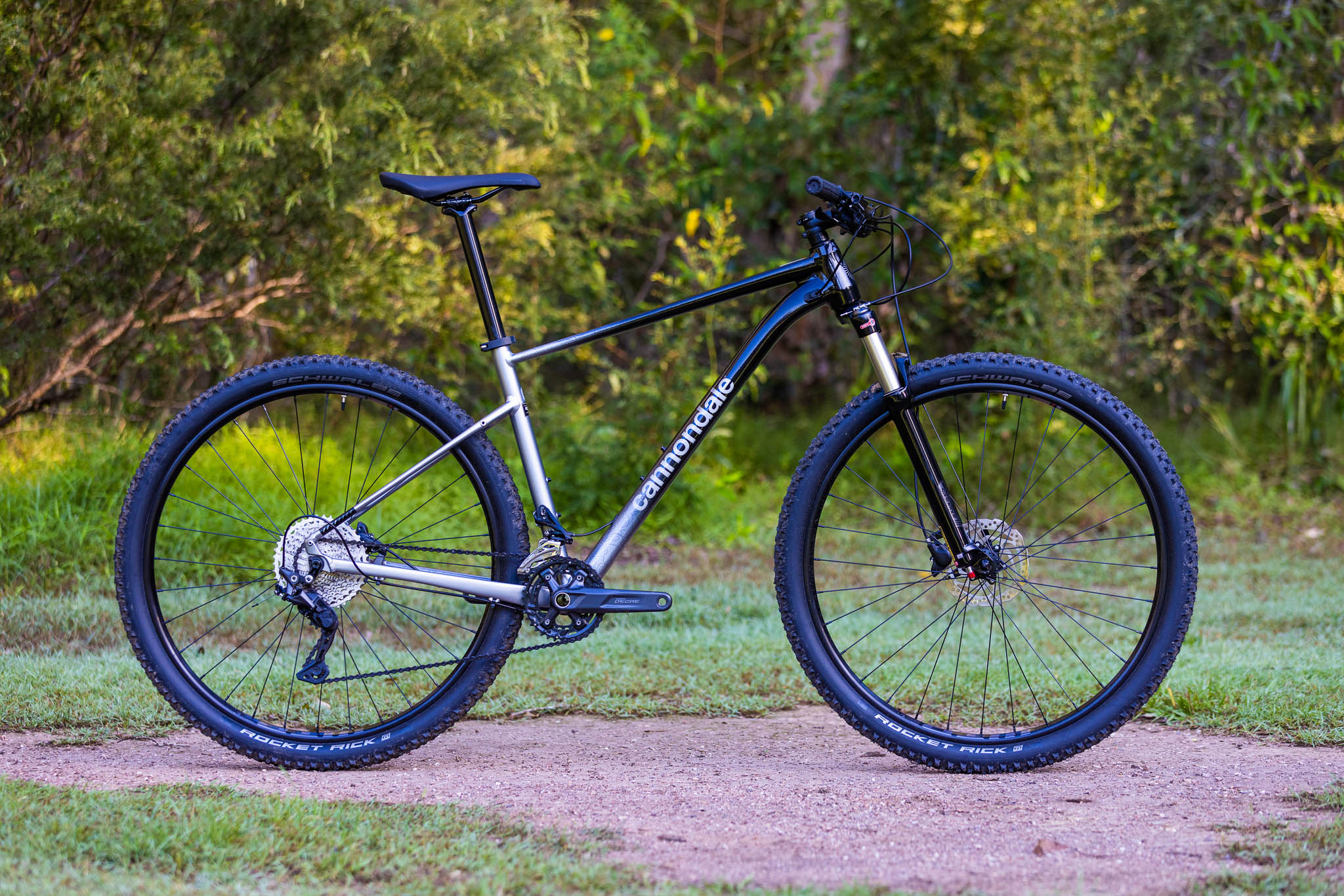
Features of the Cannondale Trail SL 4
The Cannondale Trail SL 4 has a Boost spaced frame, although it has a 100mm QR equipped front fork. This Suntour fork has rebound adjust, remote lock out, alloy legs and an air spring – all adding up to adjustability and control. It’s great to see Shimano hubs on WTB rims that are tapered, ready for a tubeless setup. 23mm isn’t overly wide, but it’s wider than many on test, and suits the purpose of the bike. The Shimano 2×11 Deore group set puts this as the only 2x bike on test – but it is a lightning fast shift with a super wide gear range.
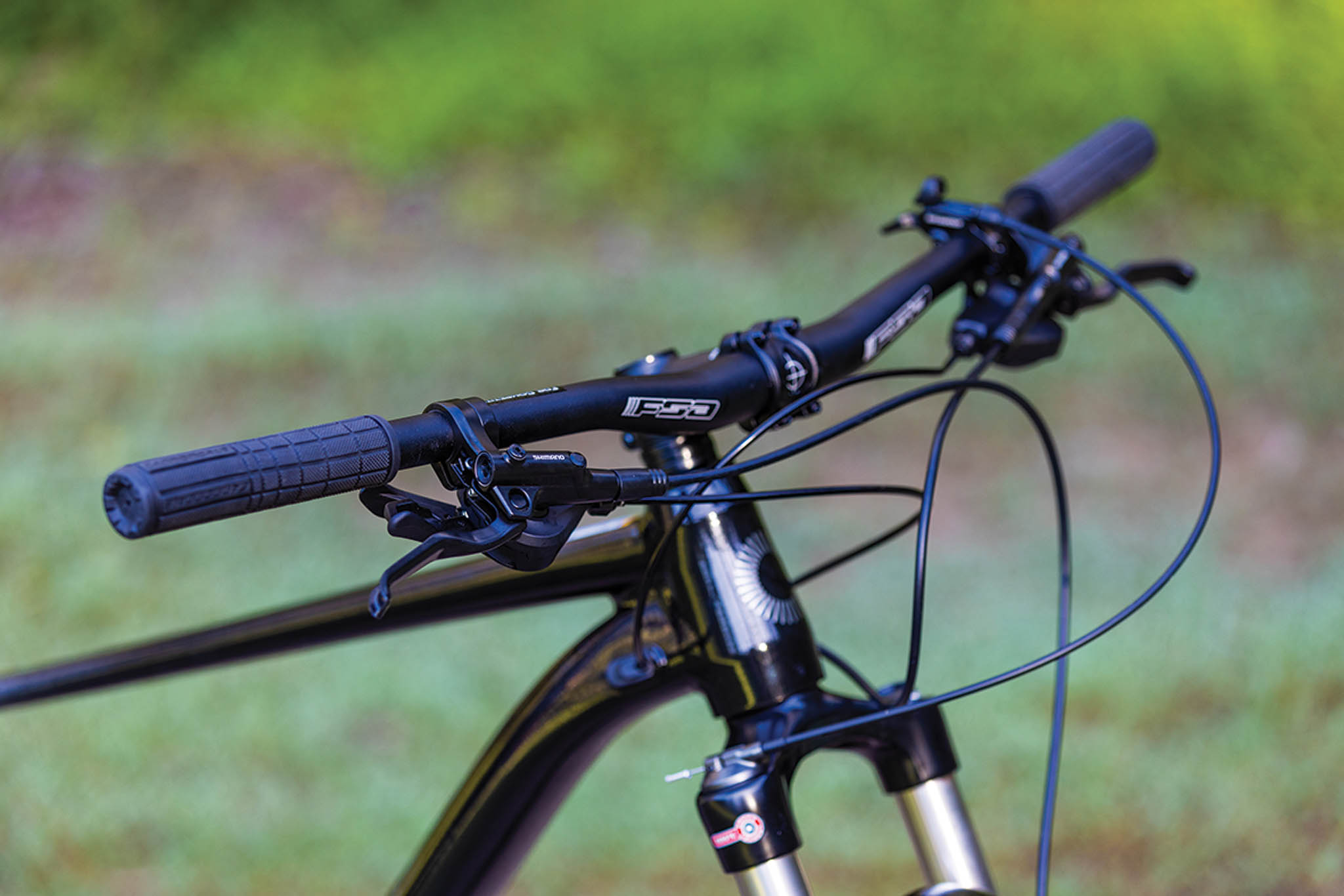
Geometry and Handling
At a glance, the Trail SL 4 shares many geometry traits of the top Scalpel hardtail from Cannondale. The 68 degree head angle is spot on for a modern cross-country hardtail like this, equipped with a 100mm fork. With the wide bars and relatively low front end, you end up with some very performance minded handling, especially from a bike that Cannondale says thrives on low impact trails and gravel roads. The 75 degree seat angle keeps you nicely centred and balanced, and works with the 444mm reach on our large test bike. The handling here is XC, but as a positive, not a swear word. It’s fast and agile, but also capable given the balanced position it puts you in.
Ergonomics
Of the five bikes I tested, this one felt the most comfortable for me out of the box. A lot of that comes to the FSA bar with a comfortable rise, sweep and width, but also the total reach and steeper seat angle for a balanced position. The lock out lever is over the bar while the front shifter is under it, I find that’s an easy combination – but it doesn’t really suit adding a dropper easily down the track, without a change to a right-handed dropper lever or lock out.
Components
I’ll start with the double chain ring. Yes they still exist, and yes they serve a purpose. The 26/36 chain ring combination and direct mount, side swing front derailleur makes for a rapid fire shift between the rings, and the tighter 11-42 cassette in the does the same. I found the shift performance absolutely faultless, along with the chain security from the clutched rear derailleur. The quick release fork and front wheel is a bit of an oversight, I would have rather seen a through axle model with Boost spacing to match the frame’s standard. It would also improve the handling at higher speeds. The brakes, wheels and tyres held no surprises, and worked as expected for the remit of the Trail SL 4.
Fun Factor on the trail
Cannondale state that the Trail SL range is ‘a mountain bike built to raise your game and ignite a passion for the trail. Designed for the mountains and ready for anything.’ They also say its strengths are handling and durability. And from my experience I cannot fault those statements.
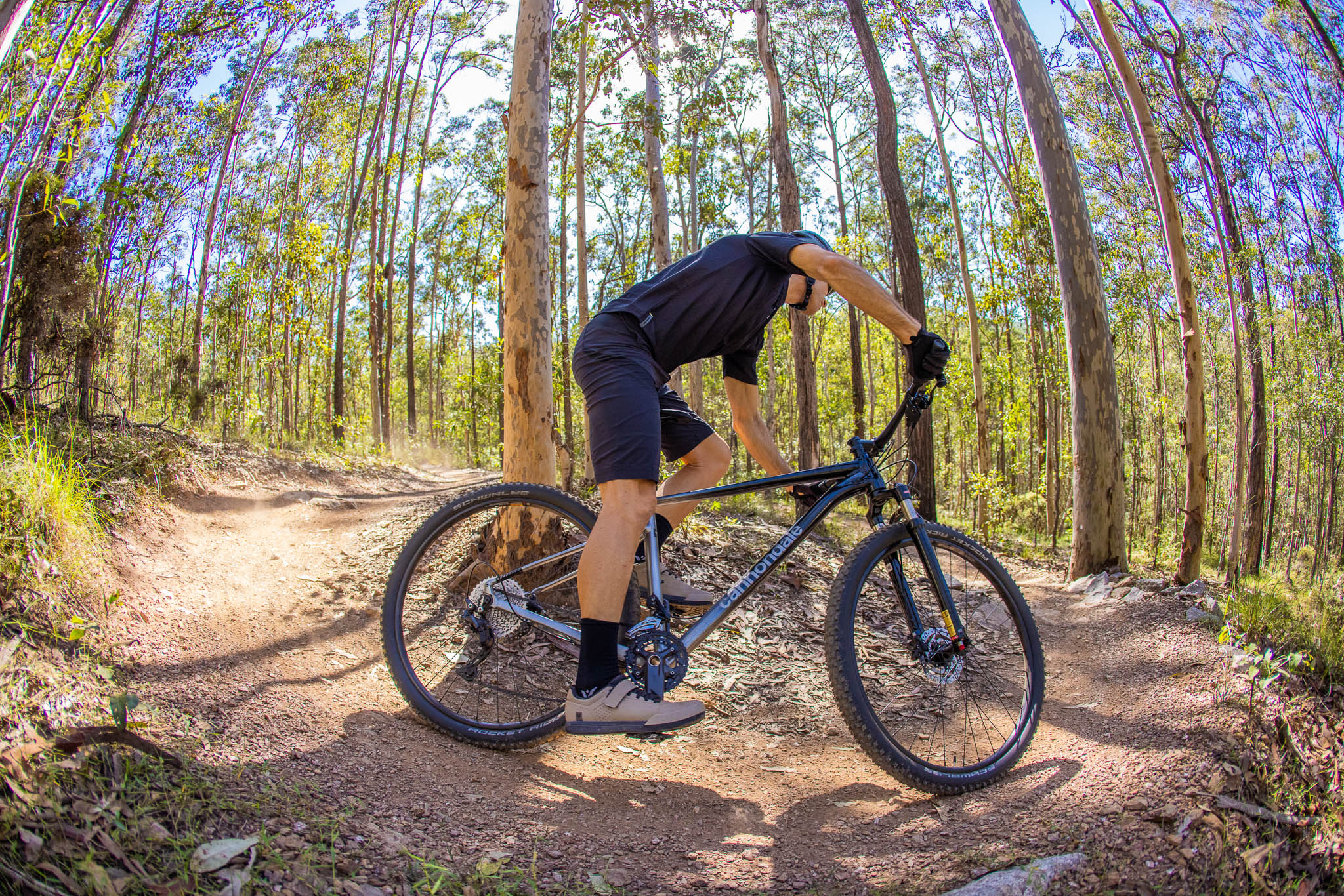
Bear in mind the Trail SL models are unapologetically XC geared hardtail mountain bikes, with the Trail SE ($2199 starting point) having slacker geometry, bigger tyres and wider rims, 1x group sets, longer travel forks and dropper posts. But to me, it’s the handling and rock solid component choices that make the Trail SL 4 what it is. The Shimano Deore 2×11 group set is an absolute workhorse. If you’re taking on gravel adventures, bikepacking trips, the commute and entry level trails, you’ll love the range and close spacing of the 2×11 gearing. The 4-bolt crank set is easy to change to a 1x ring down the track if that’s what you prefer, but as is the Cannondale is a ready to go adventure bike, capable of ripping flowing singletrack and chewing up the adventure hours in the saddle. The spacing for wider tyres, tubeless ready rims and frame mounts all speak to the versatility of the bike.
The Cannondale had very balanced handling, with the FSA bars proving to be the perfect contact point at the front of the bike. The only downside to pushing the bike a little harder than was truly intended was a little more movement than I’m used to in the front end. On all the bikes we tested, those with quick release forks did always catch us out a little, as they just don’t feel as certain in high speed corners or in rougher terrain. This certainly didn’t hold it back from being a fun bike to ride, and one that felt the most complete – running quietly and smoothly all test.
Our take on the Cannondale Trail SL 4
Cannondale have a long heritage with hardtail mountain bikes, and their entry level hardtails show that. They have added great geometry to suit the end use, with a thorough parts package that offers high quality gears and brakes, a reliable wheel set and very adjustable suspension fork. If you know you want to spend more time on faster trails and in the rougher stuff, look at the Trail SE at $2199, which has burlier wheels and tyres, 1×12 gearing, a dropper and a 120mm fork. But for all day gravel adventures, mixing commutes with trails and just having a two wheeled adventure buddy – the Cannondale Trail SL 4 is a great option that will go the distance.
Best hardtail mountain bikes under $2000
Marin Team 1 – $1999
Trek Marlin 8 – $1899.99
Merida Big.Nine SLX – $1999.99
Norco Fluid HT2 – $1699
Cube Attention SL – $1799
Reid Tract 4 – $999.99
Giant Fathom 2 – $1899
Cannondale Trail SL 4 – $1899
All parts and specifications overview
SPECIFICATIONS
Cannondale Trail SL 4
RRP $1899
Weight 14.1kg
From cannondale.com
Available Sizes S, M, L (tested), XL
Frame Material Alloy
Fork SR Suntour XCR RL, 100mm
Shifters Shimano Deore M5100 2×11
Derailleurs Shimano Deore M5100 11sp
Crank Shimano M5100, 26/36 175mm
Bottom bracket Shimano external BSA
Chain KMC X11
Cassette Shimano Deore 11sp 11-42t
Hubs Shimano MT200 QR front, MT400 Boost rear
Spokes 14g stainless, black
Rims WTB STX i23 TCS, tubeless ready
Tyres Schwalbe Rocket Ric 29x 2.25′
Brakes Shimano MT20, 160/160mm rotors
Stem Alloy
Handlebars FSA 15mm riser, 760mm
Seatpost Alloy, 31.6mm
Saddle Cannondale Ergo XC
So which of these budget hardtail mountain bikes should you buy?
This is far from an exhaustive test, but it does show a good mix of what budget hardtail mountain bikes are on the market under $2000. As noted, we didn’t test any full-suspension bikes, but there are a couple on the market that may have equivalent parts to some of the bikes here and still just sneak in under $2000.
To help make your decision, think first about what riding you will do. Do you want to ride some more technical trails, or high-speed trails with some jumps? You’ll need to look more at the trail hardtails like the Norco Fluid HT or Giant Fathom. You should also investigate the Merida Big Trail, Trek Roscoe, Cannondale Trail SE and Marin San Quentin. If you want something that’s more of an all-rounder for trails, rail trails and general use then the Merida, Marin, Trek, Cube or Cannondale are worth a look. And if you want a bike that will get you off road and let you have some serious fun for under $1000 – the Reid really does a good job of that.
Best hardtail mountain bikes under $2000
Marin Team 1 – $1999
Trek Marlin 8 – $1899.99
Merida Big.Nine SLX – $1999.99
Norco Fluid HT2 – $1699
Cube Attention SL – $1799
Reid Tract 4 – $999.99
Giant Fathom 2 – $1899
Cannondale Trail SL 4 – $1899
| Marin Team 1 | Trek Marlin 8 | Merida Big Nine SLX Edition | Norco Fluid HT 2 | Cube Attention SL | Reid Tract 4 | Giant Fathom 2 | Cannondale Trail SL 4 | |
| Weight | 13.42kg | 14.5kg | 12.34kg | 15.5kg | 13.77kg | 15.42kg | 13.7kg | 14.1kg |
| Price | $1,999.00 | $1899.99 | $1,999.00 | $1699.00 | $1,799.99 | $999.99 | $1899.00 | 1899 |
| Axle spacing front | 5x110mm Boost | 100mm QR | 5x110mm Boost | 15x110mm Boost | 100mm QR | 5x110mm Boost | 15x110mm Boost | 100mm QR |
| Axle spacing rear | 12x148mm Boost | 135mm QR | 135mm QR | 12x148mm | 135mm QR | 135mm QR | 12x148mm Boost | 12x148mm Boost |
| Number of gears | 12 | 12 | 12 | 11 | 12 | 11 | 10 | 22 |
| Dropper post | Compatible | Yes | Compatible | Yes | Compatible | Compatible | Yes | Compatible |
| Tubeless ready | Yes | No | No | No | No | No | Yes | Yes |
| Crank style | 2 piece | 3 Piece | 2 piece | 2 Piece | 2 piece | 2 piece | 2 Piece | 2 piece |
| Fork adjustments | Air spring, rebound, lock out | Air spring, rebound, lock out | Air spring, rebound, remote lock out | Coil preload adjust, Lockout, Rebound | Air spring, rebound, remote lock out | Coil preload adjust, Lockout | Air spring, rebound, lock out | Air spring, rebound, remote lock out |
| Fork travel | 120mm | 120mm | 100mm | 120mm | 100mm | 120mm | 130mm | 100mm |
| Geometry (medium) | ||||||||
| Size range | S-XL | XXS-XXL | S-XXL | XS-XL | XS-XXL | S-XL | S-XL | XS-XL |
| Reach (mm) | 430 | 440 | 398mm | 440 | 409 | 617( top tube) | 445 | 419 |
| Head tube angle (degrees) | 67 | 66.5 | 70 | 66.5 | 68.5 | 68 | 66 | 68 |
| Seat tube angle (degrees) | 74 | 73.4 | 73 | 74.5 | 73.5 | 74 | 75 | 75 |
You also need to consider sizing and fit. Some budget hardtail mountain bikes like the Trek Marlin 8 come in a huge variety of sizes, making it easier to get on the right one when you visit your dealer. Don’t underestimate the importance of being on the right frame size, and do understand it’s about the fit, not the size. One brand’s large may not fit like a large from another brand. It is worth spending a little more to chance grips or handlebars to suit your needs as well. We found all the saddles on these bikes great, and typically in this price range they are comfortable. The table shows the size ranges available, and how the fit of a medium changes between the bikes on test.
The parts on budget hardtail mountain bikes need to be taken into consideration. As we noted, some parts are exceptional at a given price point, but that is usually at the cost of something else. If you’re a tinkerer and you know you would like to upgrade a bike over time, make sure you have the frame, fork, wheels and brakes that you want – in that order. As those are the most expensive items to upgrade later. Our table shows some of the features we think are worth taking note of, including fork axles, dropper post compatibility, fork type, crank style and whether a bike is tubeless ready. We also have the weight listed – as it makes a difference.
Perhaps the most important thing if you’re newer to riding is visiting your local bike shop to build a rapport. While Bikes Online sell Polygon and Marin direct via courier delivery, that won’t be for everyone. We have been impressed with how simple the bikes are to put together yourself, and the 14 day returns option – but it may not be for you. Visit your local shop and see what bikes they have, or what they can get. Don’t like the vibe? Go somewhere else – you want to start with a good relationship.
Hopefully this has been a helpful group test, if you’re looking for budget hardtail mountain bikes that’ll still blow your hair back. Any of these hardtail mountain bikes will provide years of service with proper maintenance and care, and that means years of fun on the trails as well.

